

UK Packing list for all seasons
By: Author Tracy Collins
Posted on Last updated: May 6, 2024
Are you heading to the UK and wondering what to pack? Our definitive UK packing list has everything you need for your trip, whatever the season. Use this article with our UK Travel Packing Essentials List to ensure you have all your UK travel packing essentials.
In this article, you will find exactly what to pack for your UK vacation to ensure you are prepared with everything you need and not under (or over) packed for your trip.
There are a number of things to consider when preparing your UK packing list including:
- What time of year are you visiting the UK?
- Where are you visiting in the UK?
- How long will you be in the UK?
- What places are you visiting? (cities, countryside)
- What types of activities do you intend to do?
- Will you be based in one place or travelling around the UK?
- What transport will you be using to travel around the UK?
Planning and preparation are the best steps to ensure you pack exactly what you need for your trip. Consider your answers to the above questions as you read this article.
Read on for my essential UK packing list.
- Essential travel items – don't leave home without these!
Items you will need all year round!
Electrical equipment, guide books, toiletry bag, medicines & first aid, what to pack for uk travel all year round, what clothes to pack for london & the uk in winter, what clothes to pack for london & the uk in summer, what clothes to pack for london & the uk in spring & autumn, uk travel toolkit – available to purchase now, things to consider when packing for your trip to the uk.
The time of year you are visiting the UK can influence what you will need to pack. Broadly speaking the UK is warm in summer and cold in the winter.
The climate is however notoriously unreliable. For example, May can be a glorious month with hot sunny days one year but a gloomy washout the next.
Expect rain. And expect weather patterns to change rapidly. Sunny and warm one day but raining and chilly the next.
Packing tips to prepare for UK weather
- Pack layers so you can add or remove clothing depending on the temperature.
- Expect the weather to be cooler the further north you go (at all times of year)
- Bring an umbrella all year round. Rain is one guaranteed feature of UK weather!
Read more – When is the best time to visit the UK? Seasonal and monthly guide
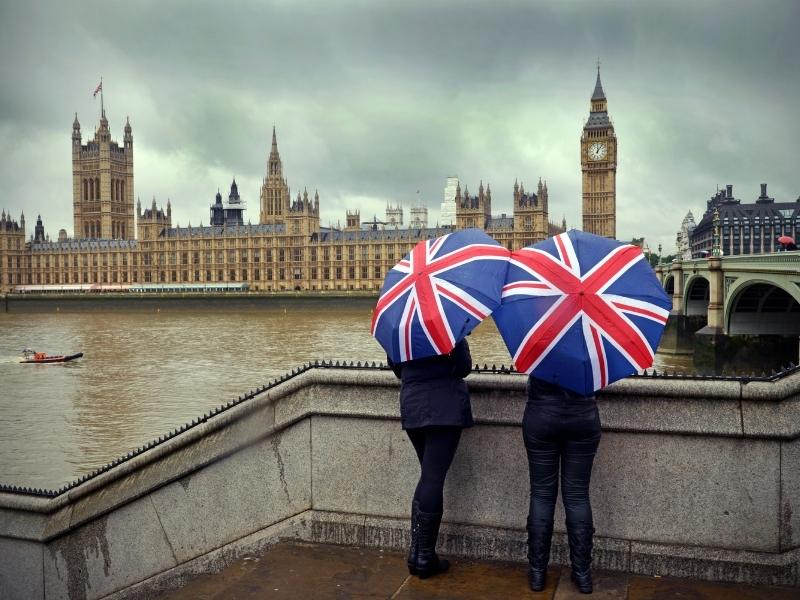
Ensure you pack comfortable footwear. If you are planning to buy new shoes for your trip make sure you wear them before you travel. There is nothing worse than acquiring a blister or two on your first day.
In winter I recommend boots. Ensure that they are waterproof to keep your feet warm and dry.
In summer sandals are fine especially on warmer days. Avoid flip flops as they are not the best footwear in the UK at any time!
Sneakers are a great option all year round and practical for most activities. Just ensure that they are waterproof.

Click to buy | Waterproof Chelsea Boots | Sketchers | Birkenstocks
I recommend planning carefully when it comes to deciding what luggage to use. If you are travelling round the UK by train for example you may want to reconsider taking an enormous suitcase!
I recommend a medium-sized wheelie suitcase for UK travel. If you want to take one carry on only it is important to check size requirements with your airline as some airlines are more generous than others.
Consider your weight allowance too. If your suitcase is full and/or at its weight limit on your outbound flight it means you can’t buy any souvenirs when you are in the UK! An expandable suitcase would be an excellent option for those of you intending to purchase gifts and souvenirs of your trip.
I also highly recommend using packing cubes as an efficient way to arrange your suitcase. It took me a while to be convinced but not I use them every time I travel. They are particularly useful if you are planning to change locations during your UK vacation as you can pack clothing into packing cubes for each destination.
Make sure your bag/suitcase is easily manoeuvrable and lightweight especially if you are intending to use public transport in the UK.
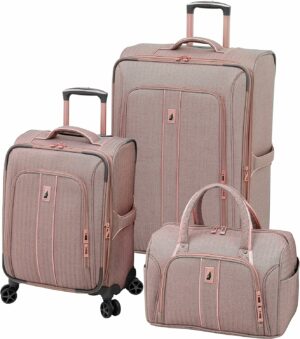
Click to buy – U.S. Traveler Rio Expandable Case | Rockland Luggage Set | Coolife Luggage Expandable Suitcase | Samsonite Softside Expandable Luggage
Essential travel items – don’t leave home without these!
- Driving Licence
- TRAVEL ORGANISER
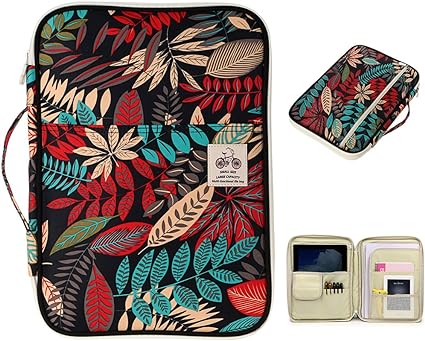
- THEFT PROOF BAG

- SMARTPHONE
- TRAVEL INSURANCE
UK packing list
- Travel umbrella
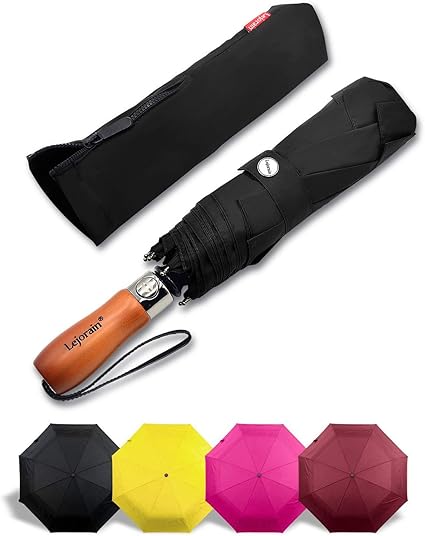
- Rain Jacket
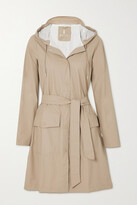
- Kindle Oasis
- Headphones or earbuds

- Universal Travel Adapter
Read – Guide to UK voltage

- Portable battery pack

- Camera Strap

- Rick Steves Great Britain
- Rick Steves London
- Lonely Planet England
- Rough Guide Scotland
Read more – The best travel guide books for planning UK travel in 2024 and beyond
Toiletries and personal items checklist
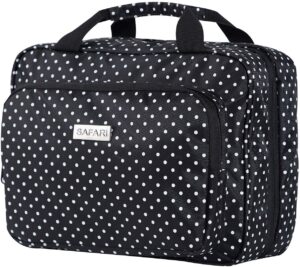
- Dental Floss
- Contact lens solution
- Hand sanitiser
- Shampoo bar
- Facial cleansing wipes
- Nail clippers

- Travel Laundry Clothesline Kit
- Portable washing bag
- Laundry bags
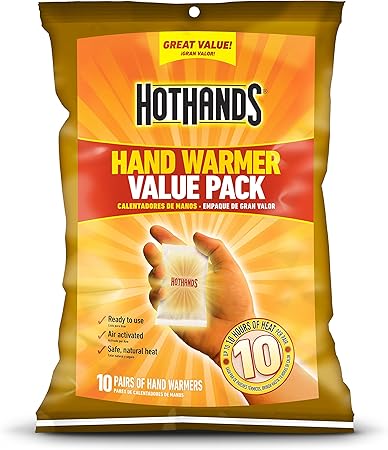
- First Aid Kit
- Vitamin tablets
- Scripts for medications
- Headache tablets
- Sun cream (summer)
- Hand warmers (winter)
I recommend taking a small selection of clothes you can mix and match.
Darker colours are best in winter. You will notice (especially if you are from the southern hemisphere) that people in the UK wear A LOT of black. Brighten up your outfits with a pretty scarf or two!
The number one rule for the UK at any time of year is to pack layers.
- Underwear x 7
- Socks x 4 pairs
- 3 x T shirts
In winter I recommend packing a decent waterproof coat, a pair of waterproof boots, warm socks, a scarf and a couple of sets of hat and gloves (so you have a spare if one gets wet)
You will discover that many shops in the UK are really hot in winter so it is useful to remove layers easily.
The London Underground can also be stifling even in winter so it is best to dress in layers to avoid overheating.
- 3 x sweater/long-sleeved tops
- 3 x leggings
- 1 x trousers/jeans
- 2 x thermal tights/pantyhose
- 2 x hat/glove/scarf sets
- 2 x Thermal vest

In summer I would swop winter sweaters for a few more T-shirts. Pack a couple of pairs of shorts, cropped trousers and linen trousers.
Don’t forget to pack a sunhat and your sunglasses.
Find more packing ideas in my UK travel packing essentials guide, which complements this post.
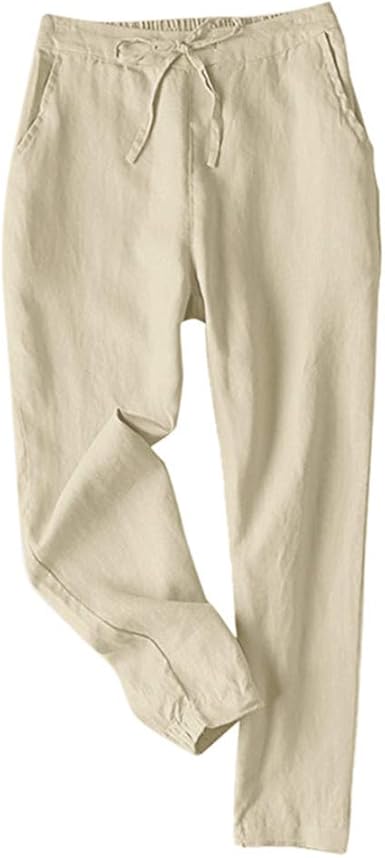
The temperatures in spring and autumn can vary wildly! Again I recommend packing layers – the weather could be warm one day and cool the next.
I would forget the shorts and pack an extra pair of jeans and/or leggings.
You should be ok with sneakers rather than boots in April/May and September/October.
Enjoy your trip to the UK!
With this packing list you will be fully equipped for your UK vacation. Just remember less is more and there are some great stores in London if you find you need an extra few items!
The UK TRAVEL TOOLKIT is the perfect resource to organize and track your itinerary.
It includes pre-travel checklists, pages for essential destination information such as hotel reservations and bookings, a packing list, budget tracking sheets, important contact numbers and addresses, tour information, flight information, car hire, train travel planner, daily travel memories as well as at a glance pages for weekly and daily itineraries.
Available to download and print off or to use as an editable planner on your laptop or iPad this is the ideal tool to reduce stress and stay organised both before and during your trip.
CLICK HERE TO FIND OUT MORE AND PURCHASE YOUR COPY
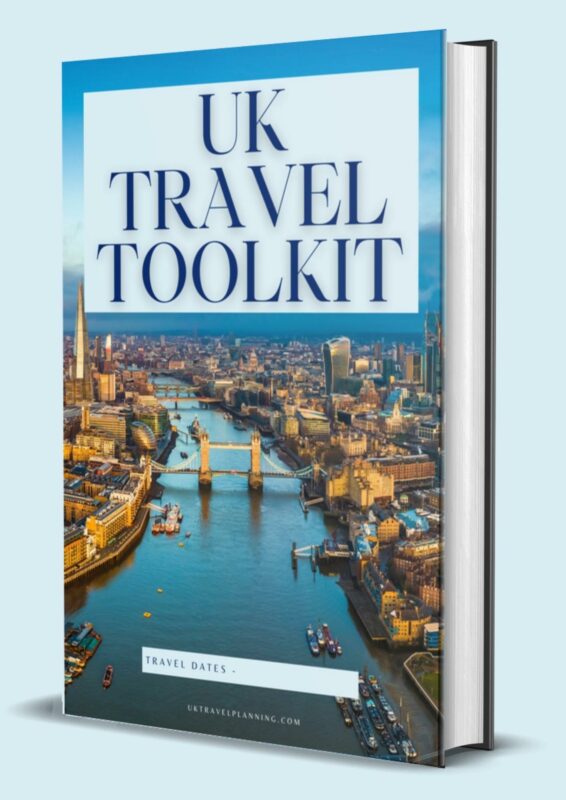

Essential UK packing list for all seasons
By: Author Tracy Collins
Posted on Last updated: September 10, 2023
If you have booked a trip to the UK you may be considering what you need to take with you. In this article you will find out all the information you need to ensure you are well prepared and not knowing under (or over) packed!
There are so many things to think about when preparing your UK packing list – when you are going , where you are going, if you will be in one place or visiting multiple locations as well as the length of time you will be in the UK.
And of course, the weather which can never be underestimated when planning any travels in the UK.
I have lived in the UK on and off for most of my life and used London as a base for my world travels in my 20’s.
Originally from the North-East I am all too familiar with the changeable UK weather and how that can influence your packing requirements when travelling to Britain.
I don’t like to overpack but believe planning and preparation are the best steps to take to ensure you have the essentials to meet your needs.
In this article, I will recommend what to bring with you on your UK holiday (and what to leave behind) – in essence, your essential UK packing list.
UK Travel Planning Facebook Group
Check out my UK Travel Planning Facebook group – come and join us! It is a great resource to help plan your UK trip – come and chat, ask questions and find out more about the UK.
- 1. The UK weather
- 2. What footwear you need
- 3. What luggage to take
Essential travel items
Uk itinerary planners, clothing, toiletries and personal items checklist, what clothes to pack for the uk winter, what to pack for the uk in summer, what to pack for the uk in spring and autumn (fall), what not to pack for your uk vacation, more practical tips to help you plan your uk vacation, things you need to consider when packing for a uk holiday, 1. t he uk weather.
I may have already mentioned this but the main consideration in the UK is the weather. Even in summer, the temperatures can change rapidly with sunshine one minute and showers the next. With an average of 164 days of rain a year you can expect some rail during your trip.
Consider where you are going and the time of year as this can significantly impact what you will need. For example, if you are travelling to Northern England or Scotland the temperatures are generally at least a few degrees colder than in London so you may need more layers to keep warm even in summer.
There are 4 seasons in the UK – spring, summer, autumn (fall) and winter.
- Spring is March/April/May
- Summer is June/July/August
- Autumn is September/October/November
- Winter is December/January/February
In winter hours of daylight are shorter than the summer months which are blessed with light evenings. The further north you go the lighter the evenings in summer (and the darker the evenings in winter)
I would recommend checking the weather forecast a week before you arrive as the possibility of experiencing extreme weather events has increased over the last 20 years with very hot summers and snow and freezing conditions in the winter occurring with more regularity.
Useful to know – In the cooler months while it may be chilly outside you will find that shops can be extremely hot. If you are wearing a thick jumper and warm coat it can feel stifling in shopping centres and on the underground. I remember Christmas shopping in London a few years ago and constantly taking my coat off and then putting it on again when I was in and out of shops in an effort to avoid overheating.
Visiting London? Read our packing list for London in the winter
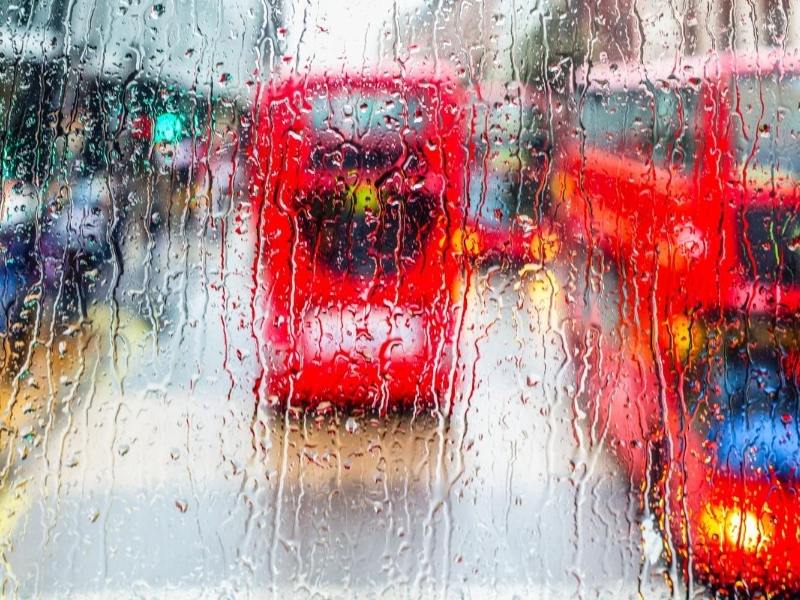
2. W hat footwear you need
An essential for any trip is comfortable footwear . There is nothing worse than acquiring a blister after a day or two on holiday. I always carefully consider what footwear I am packing and try to have at least 2 pairs. Inevitably there will be lots of walking on any UK holiday so it really is important to know what footwear you will need.
Winter – I would recommend boots as a practical option in winter. Ensure that they are waterproof to keep your feet warm and dry.
Summer – Sandals are fine for the summer months, especially on warmer days. Avoid flip-flops though as they are not the best footwear when taking the Tube (all those escalators) or on cobble-stoned streets which you may come across on your UK travels.
All year round – Sneakers are a great option and practical for most activities. Just ensure they are waterproof.
Tip: If you are purchasing new boots/shoes/sandals try to wear them before your trip so you are 100% confident that they are comfortable.

3. W hat luggage to take
When preparing for your trip the inevitable decision will have to be made about the type of luggage, how many bags and whether to carry on or check them in at the airport. I ask myself the following questions before deciding:
How will you transfer to your hotel from the airport?
If you are taking public transport consider how difficult it may be to travel on trains/buses with a 20kg suitcase. It may be easier to book an airport transfer to your destination but if you prefer public transport ensure your luggage is easy to manoeuvre.
Are you staying in one location or moving around?
If you are staying in one location once you have arrived and unpacked you can relax. If you are travelling to multiple destinations packing and unpacking can become a chore so think about ways of making this easier. I find packing cubes a great way to pack my belongings and extremely useful on multi-centred trips.
Again it is important to consider how you will be travelling – if you are hiring a car you will be able to take more with you than if you are planning to move around by train. Though it may be worth considering leaving some luggage with a hotel if you are using it as a base at the beginning and end of your holiday e.g London.
Will you have access to laundry facilities?
For a 2/3 week holiday, I pack enough clothes for a week and wash items as I go. Hotels generally provide a rapid laundry service and I find smaller items dry quite quickly when hung up.
Are you planning to buy lots of souvenirs?
If you are planning to buy lots of gifts or souvenirs make sure you leave enough room in your suitcase to fit them in.
On a trip to Italy with my niece a few years ago she ended up throwing away clothes to be able to fit all her purchases into her suitcase!
My UK packing recommendations
√ Suitcase

This elegant but extremely functional suitcase by Coolife is guaranteed to meet your luggage requirements.
Available in a number of colours and sizes this hard-shelled case comes with a built-In TSA lock for peace of mind.
The spinner wheels and adjustable 3-level telescoping handle allow you to quickly manoeuvre in tight spaces. The interior is fully lined with multi-use organisational pockets which make packing a lot easier.
√ Packing cubes (and my new favourite compression packing cubes)

I am a recent convert to compression packing cubes and seriously wonder how I managed without them. A perfect way to organise your packing especially if you want to take a smaller bag but fit more in it!!
I would highly recommend buying a set or two for your travels.
I try to be very organised when I travel to reduce stress and anxiety, especially at airports. These are essential items to take with you on any international trip and are always at the top of my personal checklist.
√ PASSPORT
Don’t forget your passport! Check the expiry date. Some countries won’t let you enter unless your passport is valid for 6 months after your planned departure date.
If it needs renewing do it asap.
Keep a copy of your passport in a separate place.
√ VISA
Nationals of the US, Canada and Australia do not need to apply for a visa prior to arrival. You will be granted a visa for a stay of up to 6 months at passport control upon entry into the UK.
For up-to-date information regarding visa requirements click here to check the official UK government website. If you intend to visit the rest of Europe you may need to apply for a separate Schengen visa .
√ DRIVING LICENCE
You can drive for up to 12 months in the UK if you have a valid driving licence (issued in English) from your own country. Drivers with licences that are not in English are required to have an International Driving Permit when driving in the UK.
International Driving Permits are also required for any non-EU citizens when driving in Europe.
Prepare to drive in the UK with the help of Tripiamo .
Tripiamo is an excellent resource which provides an engaging and informative way to prepare through their online guides which include video lessons explaining things such as traffic rules or driving etiquette.
Listen to our recent podcast episode where I chat with John Cortese (the founder of Tripiamo )
√ TRAVEL ORGANISER

We keep all our important documents together in an organiser like this one . This makes it much simpler to find what you need quickly rather than rifling through lots of bags.
I also save any documents electronically and ensure I have a paper copy and an electronic copy of our itinerary.
√ Wallet

I have a small wallet that I use for travelling. I take a couple of credit cards plus cash. (Don’t forget to let your bank know your travel dates so they don’t suspend your card for suspicious activity)
I recommend a wallet with RFID blocking for greater security.
√ THEFT-PROOF BAG

I own a variety of sizes of theft-proof bags and always take at least 2 with me when I travel. It is a sensible precaution to take when travelling to protect your money and belongings from pickpockets.
Unfortunately, there are gangs operating throughout Europe and tourist sights and public transport are particularly targeted.
The bags are available in a variety of sizes.

Read my essential buying guide to anti-theft bags and my guide to the best mini theft-proof bags.
√ SORT ACCESS TO WIFI
- Check data roaming fees before you arrive.
- If you have an unlocked and compatible phone there is always the option of purchasing an e-sim mobile data plan
- Many hotels offer free wifi too so check when you book if it is essential.
- Consider hiring a portable WiFi device such as this one which can be used by everyone in your party and picked up on arrival at Heathrow airport.
Learn more – Read my comprehensive guide to accessing WiFi in the UK including a comparison of the best SIM card options
√ TRAVEL INSURANCE
I always ensure I have travel insurance before I leave.
It is one of those things you hope you will never need, but if you do, the peace of mind it provides is worth the few dollars it costs.
Essential packing items for any time of year in the UK
These are my UK travel essentials which should be included in any packing list for UK visitors. These posts are also helpful when planning your packing list for UK travel:
- 30 incredibly useful mini travel products you need for your next trip
- 10 essential mini beauty travel products
√ Repel Windproof Travel Umbrella

It rains a lot in the UK and this can range from a short shower to days of torrential rain so an umbrella is pretty much essential. I recommend a travel umbrella which you can keep in your bag.
Even if the weather looks good before you set out I would take it as a raincloud could literally appear from nowhere.
√ Rain Poncho

I love this stylish reversible rain poncho. The poncho style enables it to be worn over jumpers and even a backpack to keep both you and your belongings dry.
The colours are fun and stylish and provide a useful addition to your travel wardrobe.
√ Kindle

I love my Kindle and as an avid reader find that I no longer waste my baggage allowance or space in my bags with books.
A Kindle is light and portable and can store thousands of books. Why not download some of my recommended top fiction and non-fiction books about England to read during your trip?
√ Universal Travel Adapter and/or power strip

Don’t forget to pack a travel adaptor or you won’t be able to use any of your electrical equipment in the UK.
I have recently started travelling with a power strip and have found it fantastic.
√ Insta360

I use both my iPhone camera and an Insta360 camera to capture videos and images on my travels.
√ Memory cards

Don’t run out of space for all those fabulous memories you will be making. I always carry at least 2 spare memory cards just in case.

Simplify your travel planning with a set of one-page UK travel itinerary planners for 9 popular cities & areas across England, Scotland & Wales.
Planning your trip can be fun but it can also be stressful. There are SO MANY places to visit and things to see and do in the UK that it can feel overwhelming.
Researching how to spend your time can lead to information overload.
The good news is that we have done the hard work for you. Our UK Travel Destination Itinerary Planners are the perfect solution and condense everything you need to know into one page for each of 9 of the UK’s most popular destinations.
Click for more information about our planners
√ Travel Laundry Clothesline Kit
√ Sewing kit
√ Mini First Aid Kit I am married to a nurse so he always makes sure we carry a small first aid kit with all essentials.
√ Pain relief tablets If you need to purchase over the counter medications while on holiday look out for a Boots Chemist which is one of the largest chain of chemist stores across the UK
Seasonal packing lists – What to pack for the UK throughout the year

Dark coloured clothes are the norm in the UK and Europe during the winter months. I tend to stick to black with pink/grey or another colour to add some brightness to my wardrobe.
Dress is fairly casual in the UK with a winter jacket, jeans, waterproof boots, woolly hats and a scarf the mainstay of winter fashion. My recommendation is to wear layers so if you feel hot in a shop/on the underground ( if you are planning what to pack for London in particular ) you can take off your coat to cool down.
I really don’t recommend bulky sweaters, especially when spending a day in a city such as London. It can be incredibly hot in shops and in shopping centres or on the underground so unless you are planning to spend a day in the countryside exposed to the elements don’t pack thick sweaters!
Your main issue when visiting the UK in the winter (and spring/autumn) may be the damp rather than really cold temperatures. When packing think of layering with plain t-shirts and long-sleeved tops.
These are all items that would provide an ideal winter wardrobe for your UK trip and are worth adding to the essential packing list detailed above.
For more information about what you need for your UK holiday during the colder months read my essential packing list for London and the UK in winter.
√ Footwear Ensure any footwear is waterproof and has a textured sole to maintain a grip on uneven and slippery surfaces. I always take a pair of boots and a pair of sneakers.
√ Skechers sneakers
√ Coat
√ T-shirts/Long-sleeved tops
√ Hat, scarf and gloves – I always take 2 sets in case one gets wet and needs to dry. This is especially true in the UK when it can be very damp. Add a little colour to your outfit with this set of gloves, hat and scarf.
Good to know – If you are planning to visit Harrods do not wear ripped jeans or flip flops or you will be prevented from entering by the doorman.
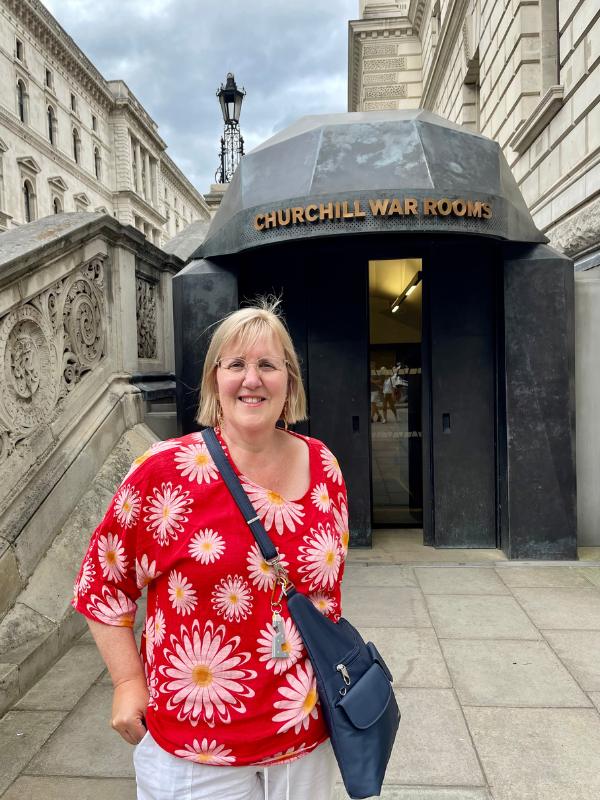
Don’t be surprised if people start appearing in flip-flops, maxi dresses, shorts and vest tops if temperatures reach highs of 16 or 17 ° C (around 60° F). And if temperatures reach a balmy 20° C or more (68° F) the newspaper headlines start declaring a heatwave.
London can become incredibly hot in the summer and in fact the UK in general has experienced some fairly good summers recently. However, I would always err on the side of caution and ensure you have a jacket or cardigan with you at all times in case temperatures drop.
Additional items to include in your UK and London packing list for the summer months:
√ Jacket – A lightweight jacket (preferably waterproof) should be fine for the summer months but again check temperatures if you are heading further north. Even on hot days it can be cool on the east coast if there is a sea fret (a cool mist that comes in from the sea)
√ Cardigan/Pashmina – I recommend taking a couple of cardigans and a pashmina to keep you warm in the evenings or when there is a cool breeze. Consider neutral colours which can be worn with your other clothing.
√ Sandals – I love my Birkenstock sandals and have a few pairs. I find them stylish and comfortable (well as stylish as comfortable sandals can be)
√ Linen trousers/ cropped trousers – I love linen trousers and have about 10 pairs that are the mainstay of my wardrobe during the summer months in the UK
√ Summer skirt or sundress
√ Swimming costume – If there is a swimming pool in your hotel.
√ Sun hat – Protect yourself from sunburn so don’t forget your hat!
√ Bug spray – If you are visiting the countryside I would suggest taking bug spray. This is essential for Scotland in summer when the midges will be out in full force.
√ Reusable water bottle – this collapsible travel water bottle is ideal

Temperatures average between 5° – 13° in spring (40- 55°F) and between 14°- 8° (57- 46 °F) in autumn in the UK.
Spring is a lovely time to visit the UK with daffodils and bluebells heralding the warmer weather. It is also quieter than the peak summer months which coincide with the long 6-week summer break for schools.
Visit in autumn to enjoy the beautiful colours as leaves turn from green to yellow, orange and red. Rainfall tends to be less frequent in spring and autumn than in the winter months but still prepare by packing a raincoat and/or an umbrella.
Depending on the exact month you are arriving (nearer to winter or summer) I would adjust your packing accordingly including some of the recommended items above.
I would recommend not packing any of the following items or adding them to your UK holiday packing list
⊗ Flip flops – best kept for your trip to the Mediterranean/Caribbean. The UK was really not made for wearing flip-flops (well maybe you can for a few days a year)
⊗ Big bottles of shampoo/conditioner . If you want to take your own brand decant them into smaller travel-size packs or why not try some of the solid shampoo bars that are available?
⊗ Hairdryer – most hotels provide one.
⊗ Expensive jewellery and valuables – leave them at home and avoid losing them (or worse having them stolen)
⊗ Too much!
I am sure that my packing list for London and the UK has been helpful and has given you some practical tips. You may also enjoy reading my UK travel tips and planning guide which includes all the steps needed to plan a great UK holiday.
If there is anything I have missed out or alternatively if you have found this useful please let me know in the comments.
- Read – Things to know before you visit England for the first time
- Read – Things to know before you visit London for the first time
- Watch – Our guide to popular British TV series
- Check out our other websites – UK Travel Planning and London Travel Planning
Don’t forget to join my UK Travel Planning Facebook group where we share further ideas, tips and inspiration.
16 local tips to know before traveling to England

Jul 13, 2023 • 7 min read
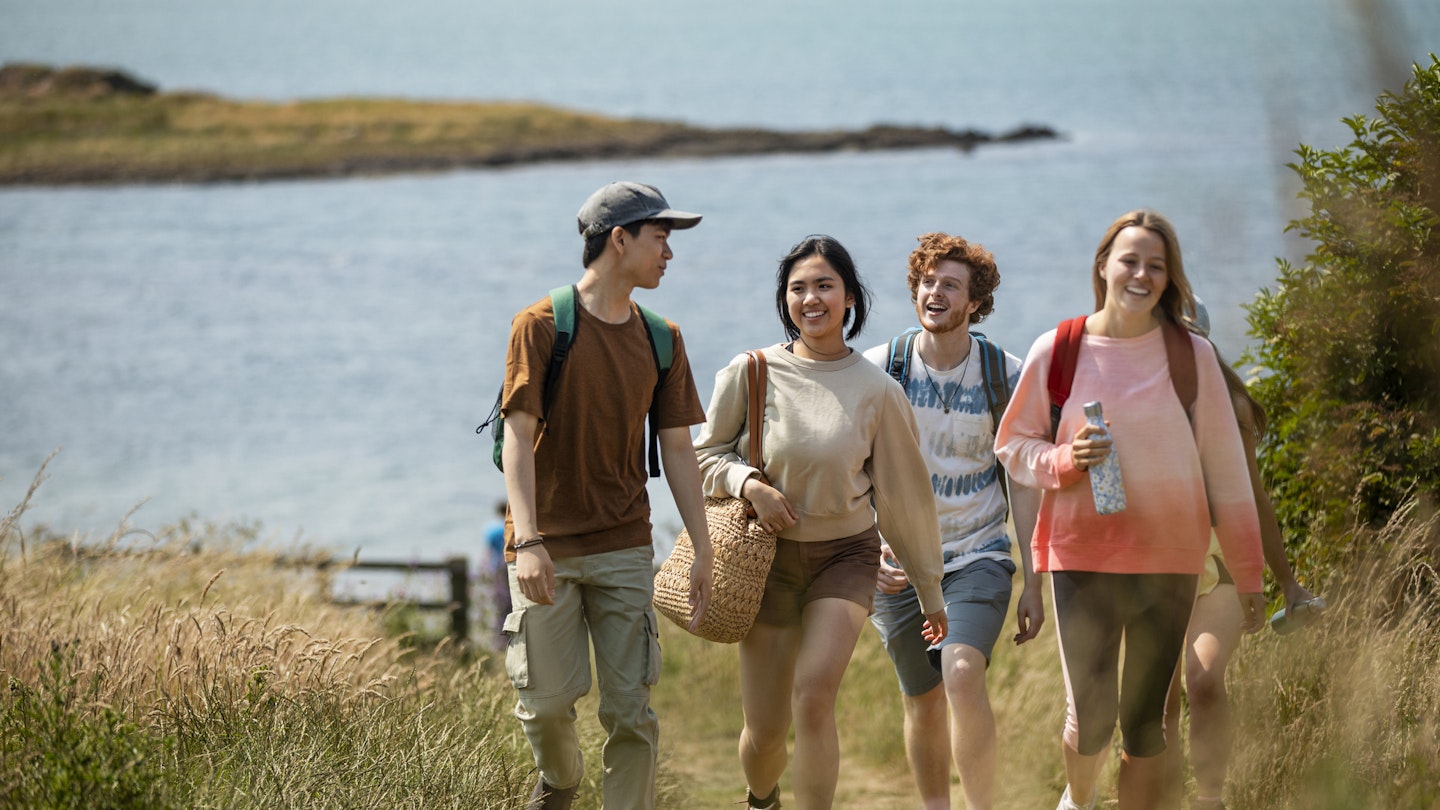
These top tips will help you be prepared for anything on your trip to England © SolStock / Getty Images
Such is England’s reach on popular culture, you may think you already know the country before you visit.
Though if you’re expecting to be surrounded by a bunch of well-heeled James Bonds or a gaggle of eccentric Monty Python characters, then think again.
While the everyday English aren’t quite the same as how they’re portrayed in film, television and books, this is a country with a number of peculiarities that are good to know before visiting, especially when venturing outside of London . From practicalities like train prices to etiquette tips on how the English approach queueing, it’s always important to be ahead of the game when visiting this wonderful and varied country.
Here are a few key things to know before traveling to England.

1. You should pack a jacket, even in summer
Preparing for all types of weather is an essential part of the English experience. England’s maritime location in the wild North Atlantic means that even in summer , biting winds and untimely rain showers can unexpectedly scupper a balmy afternoon.
That doesn’t mean you need to take an umbrella everywhere, but you do need to put a jacket in your suitcase and always check the conditions on your favorite weather app before venturing out. As a rule, London is usually a couple of degrees warmer than other parts of the country.
2. Be ready to discuss the weather
Talking about the weather is in the English blood and a part of the national psyche. And the more lamentable the forecast, the more likely people are to talk about it. Come rain or shine, prepare to offer an opinion on the day’s weather, and express that it’ll hopefully brighten up/cool down as the week goes on.
3. Train prices are steep
Unlike some other countries in western Europe , England’s train system was privatized many years ago, and this, along with other factors, has lead to some of Europe’s highest train prices.
Try to book ahead of time (around 12 weeks before travel for the best rates) and look out for cheap advance fares. While not as quick as train travel (and certainly not as romantic), coaches such as National Express and Megabus offer far cheaper prices when traveling across the country and are highly recommended for those on a budget.
4. There’s a whole world outside of London
London’s big, bold, and full of iconic English landmarks and experiences . But it isn’t everything. If you have the time to explore beyond the capital, you’ll discover a variety of landscapes, people and cultures, and some wonderful things to do .
From the wild coastlines of Cornwall to the soaring hills of the Lake District , there’s much to see in this ancient land.
5. Crossing the English Channel means different plug sockets
Yes, England is in Europe, but it doesn’t always play by European rules (in more ways than one, with Brexit still something that people can't agree on seven years after the vote). If you’re backpacking around Europe, remember that the UK and Ireland use type G plug sockets (three rectangular pins in a triangular pattern), so make sure you have the right power adapter when arriving in England as it differs from the rest of the continent.

6. Many museums are free
England is home to many of the world’s greatest museums , and you won’t need to pay a penny to enter some of them. Especially great for rainy days in London, you can peruse dinosaurs at the Natural History Museum or masterpieces by Turner at the National Gallery and spend the money saved at the pub later on.
7. Pronouncing place names will be a challenge
Alongside some truly bizarre place names, England also has several towns and counties that aren’t pronounced the way they are spelled. Names with a -ter suffix are particularly notorious for this.
Bicester is pronounced biss-ter rather than bi-ces-ter, Gloucester is pronounced gloss-ter rather than glou-ces-ter, Leominster is pronounced lem-ster rather than Leo-minster. You get the picture.
8. Hit the beer garden when the sun comes out
The English need no excuse to go to the pub on a sunny summer afternoon, and sitting indoors is almost unthinkable. Find a table in the beer garden at the local boozer and order in a few cold pints. Job done.

9. Expect to hear a different accent in each region
Traveling just a few short miles in England can often mean a change in accent, so train your ears to prepare for this. Regional accents are hugely diverse, and while they’re still English, they can sometimes be difficult for even fellow England residents to understand.
The accent you’ll hear in Birmingham ("Brummie") differs wildly to what you’ll hear when you arrive in Newcastle ("Geordie"). London is a separate case as it’s so cosmopolitan that you can expect to hear a variety of different accents and languages throughout the day.
10. Never jump a queue
Sometimes polite to a fault, the English are very orderly when queueing, and those who jump a line can expect stern looks and grumbling at the very least. So get in line and patiently wait your turn to avoid any awkward situations.
11. You’ll hear "sorry" a lot
Even in situations where the fault lies with you, you might receive an apology. Only Canadians say sorry more than the English, so get used to hearing it and, eventually, saying it.
12. English food does not deserve its negative reputation
Stereotypes about the English are often amusing and sometimes painfully true, though the one about the poor standard of English food can be comfortably consigned to history’s trashcan.
Towns and cities across the country are now dotted with superb restaurants offering a strong emphasis on fresh and locally grown produce. Alongside traditional dishes , you’ll find cuisine here from all over the world amid an ever-growing list of Michelin-starred restaurants.
13. Beer standards are high too
The pub is a rite of passage here, and the English love a pint of beer. But England has grown out of its cruel 1970s caricature of warm stale beer, and these days, there are myriad styles to sample, up and down the country.
From real ales at historic Victorian pubs to craft beer at bright modern taprooms, choose from sours, stouts, saisons, New England IPAs and beyond.

14. Summer is festival season
From Glastonbury in June to Reading and Leeds in August and everything in between, there are lively music festivals running throughout the summer in England. No matter what week you’re here, there’s bound to be a festival on somewhere. Getting tickets for the big events is a challenge, though – you'll need to look out for those around nine months in advance.
There are also a plethora of smaller festivals that are often great value and easier to navigate too, such as Birmingham’s superb Mostly Jazz, Funk & Soul Festival .
15. If you encounter any health issues, you’ll be in good hands
Visitors from EU countries will be covered for some treatment on the National Health Service (NHS) if they fall ill during a visit by using their European Health Insurance Card (EHIC). Visitors from non-EU countries with a reciprocal health care arrangement with the UK may also be covered for some treatment needs, particularly emergencies.
16. Measurements can be confusing
Don’t be surprised if you get into a metric muddle. For some things, the English use metric measurements, and for other things, they use imperial. Though metric measurements became legal in the UK back in 1875, Britain has never fully transitioned to using metrication in all situations. Roads are still measured in the imperial unit of miles, for example, and height is often discussed in feet and inches.
This article was first published Jun 26, 2022 and updated Jul 13, 2023.
Explore related stories

May 30, 2024 • 6 min read
From tickets and terminals to queues and border crossings, here’s everything a first-time Eurotunnel user needs to know.

May 28, 2024 • 9 min read

May 21, 2024 • 4 min read

May 14, 2024 • 7 min read

May 3, 2024 • 14 min read

Apr 19, 2024 • 10 min read

Apr 19, 2024 • 8 min read

Mar 31, 2024 • 6 min read

Mar 30, 2024 • 4 min read

Mar 28, 2024 • 6 min read
Key items to pack for a UK trip (in any season)
Recently updated on April 23rd, 2024 at 02:47 pm
If you’re looking forward to your trip to the UK, you’re probably wondering what to pack and what to wear. With four changing seasons, unpredictable weather ranging from freezing to hot temperatures and almost guaranteed rain, it pays to be prepared before you head off on your UK adventure. Whether you’re travelling in summer or winter, or somewhere in between, here are the essential items to pack for your tour to the UK .
What to pack for a trip to the UK in winter
Warm, layered clothes.
The most important thing to pack for your tour to the UK in winter is warm clothes. The average winter temperature ranges from 0 to 7°C, so you need to get strategic about how you’ll rug up on your trip. We recommend layering up with jeans, long-sleeved shirts, woollen sweaters or down jackets, and a water and windproof winter coat over the top.
You can even pull on some thermals as your first layer if you’re prone to the cold. Remember that it can get quite hot if you’re catching the tube in London or visiting shopping centres, so wear layers you can easily strip off if you need to.
GET INSPIRED BY: Best of Britain
View this post on Instagram A post shared by Love Great Britain 🇬🇧 (@lovegreatbritain)
Warm accessories
Don’t forget your gloves, scarves, thermal socks and woolly beanies! You might like to go for gloves with touch pads so you can still use your smartphone, and a winter hat that covers your ears.
Go for a comfortable pair of walking shoes or boots – bonus points if they’re waterproof. You don’t want to trudge around all day with wet feet.
RELATED CONTENT: The 14 best Christmas markets to visit in the UK
What to pack for a trip to the UK in summer
Versatile clothing.
In summer, the temperatures in the UK average around 17°C to 25°C – but don’t be surprised if they soar even higher at times and the newspapers start declaring a heatwave. London in particular can be very hot in summer, so you can pack summer clothes like shorts, t-shirts, skirts and dresses. Don’t forget to pack warmer layers like a waterproof coat, cardigans and trousers, as you never know when the weather can change.
GET INSPIRED BY: Britain and Ireland Grandeur
Whether you’re going to the pool or the beach, take advantage of the warmer temperatures and bring your swimsuit on your summer trip to the UK.
You’ll still need a comfortable (preferably waterproof) pair of walking shoes, and a pair of sandals is also great for a summer trip to the UK.
Insect repellent
The insects come out to play in summer in the UK, so bring some insect repellent to ward off any creepy-crawlies.
RELATED CONTENT: 15 of the prettiest places to visit in England
What to pack for a trip to the UK in spring and autumn
Layered clothing.
With temperatures averaging between 12-20°C across spring and autumn, you really need to prepare for anything, from warm sunny weather to cold rainy days. The best way to do this is by layering up. Bring t-shirts, long-sleeved shirts, cardigans, sweaters, leggings, skirts, dresses, jeans, trousers and a scarf. Then mix and match your outfits so it’s easy to peel off layers if it warms up, and it’s just as easy to get them back on if the temperature drops.
Bring your comfortable pair of walking shoes or runners, and you can even bring a pair of sandals if the weather forecast looks bright.
RELATED CONTENT: Where to retrace the footsteps of Beatrix Potter in the UK’s Lake District
View this post on Instagram A post shared by VisitEngland (@visitengland)
Essentials to pack in every season in the UK
Whatever the season, it’s all about layering in the UK. And remember, you will need a waterproof coat in every season. They’ll just differ in the warmth and weight depending on the time of year.
Trafalgar tip: If you plan to visit Harrods, the famous luxury department store in London, don’t wear ripped jeans or flip flops as you won’t be allowed in.
RELATED CONTENT: 11 quintessential British rom coms to make you fall in love with the UK
Windproof travel umbrella
The UK gets a lot of rain. In 2019, there were 164 days in which rain fell . It can range from light showers to torrential rain and snow, and it can rain in any season at any time. We recommend coming prepared with a windproof, travel-sized umbrella so you don’t find yourself running for cover whenever the skies open. That way you can do as the locals do and “keep calm and carry on” – even when it rains.
RELATED CONTENT: 8 Unusual Things to Do in England
Sun protection
You’ll need sun protection in every season, even winter. Although there may not be much sun, there’s a lot of glare (especially when it snows) and the harmful UV rays can still be quite strong. Protect your skin all year round with sunglasses and sunscreen.
GET INSPIRED BY: Best of Scotland
Reusable water bottle
Help reduce plastic waste and bring your own water bottle. Tap water is safe to drink across the UK so you can easily refill it everywhere you go. You’ll save money on bottled water and the planet will thank you for it, too.
Keep your hands free and bring a backpack, cross-body bag or fanny pack to hold all your daily essentials like a water bottle, sunscreen, umbrella and all your souvenirs.
Pound sterling
The official currency of the UK is the pound sterling. While there are ATMs and credit card facilities across the region, it’s still a good idea to bring some local cash with you.
RELATED CONTENT: Truly local experiences in Northern England you can only enjoy with Trafalgar
Camera and extra memory cards
It goes without saying that the UK is picture-perfect in every season, and you’ll want to take hundreds of photos to capture your incredible trip. Remember to bring extra memory cards, an extra charger and a waterproof case for your camera or smartphone.
RELATED CONTENT: Relive Princess Diana’s best moments at these 5 iconic UK locations
UK travel adaptor
The UK operates on plug type G. It has three rectangular pins in a triangle pattern, and it’s good to note that the UK uses a 230V supply voltage and 50Hz.
Which iconic spots are at the top of your UK bucket list? Let us know in the comments below!
Want to hear more from us?
Sign up to receive inspiring travel articles, offers & news
" * " indicates required fields
Privacy Overview
Finding the Universe
Travel tales, photography and a dash of humor
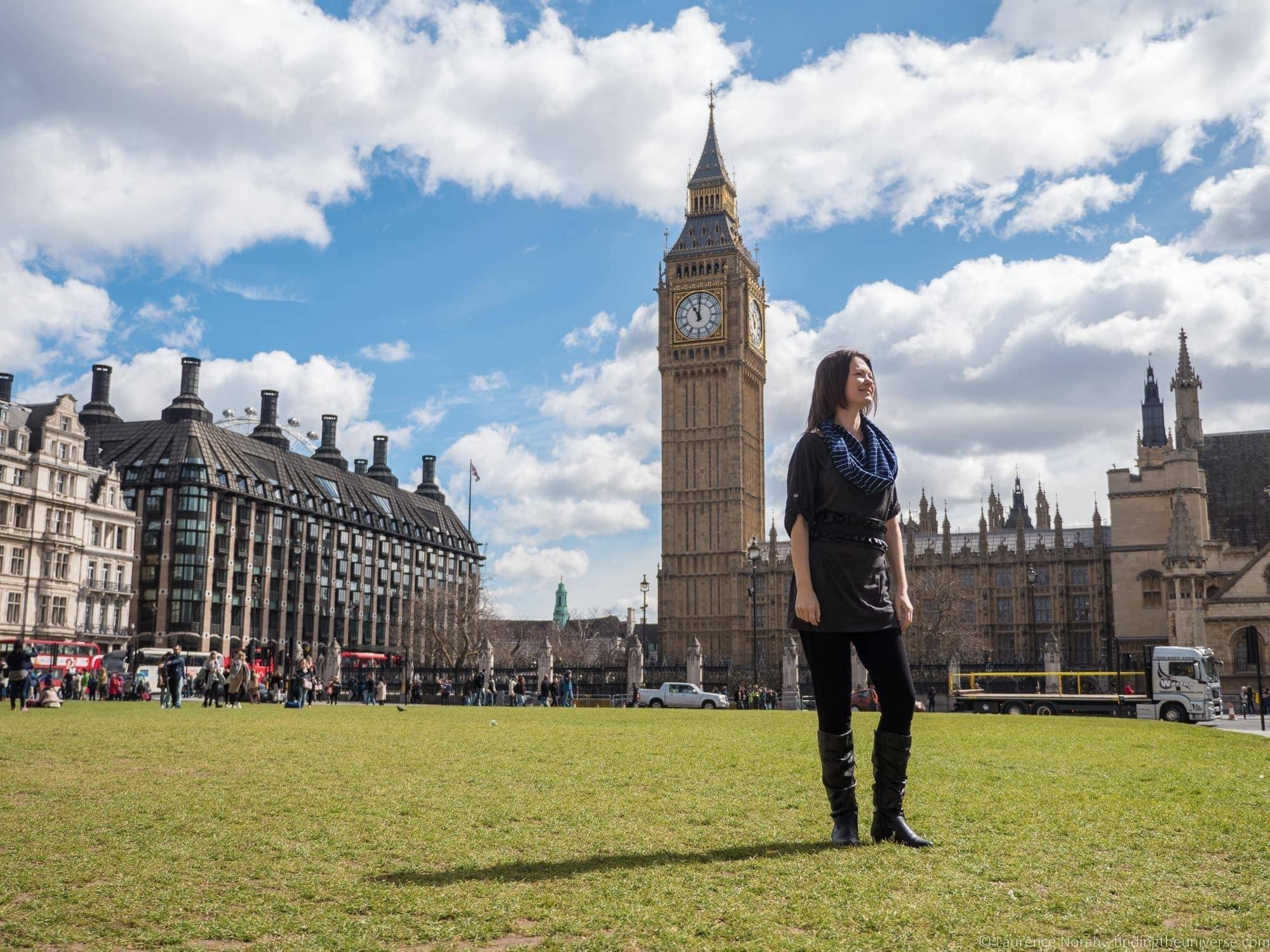
London Packing List: What to Pack for London and the UK at any time of year
Last updated: May 28, 2024 . Written by Laurence Norah - 29 Comments
We’ve spent a great deal of time travelling throughout the UK, plus we’ve taken many trips to London, a city we love to visit. I even lived in London for a number of years.
There’s so much to see and do in London that we find ourselves returning time and again for new adventures – everything from seeking out Harry Potter sites to hitting the Winston Churchill trail .
Based on our experiences, we wanted to put together a guide to what to pack for London, to help you when planning what to bring.
This London packing list will also work for visiting other cities and parts of the UK and is designed for visiting London and the UK any time of year, with some items being more required in winter or summer, and noted as such.
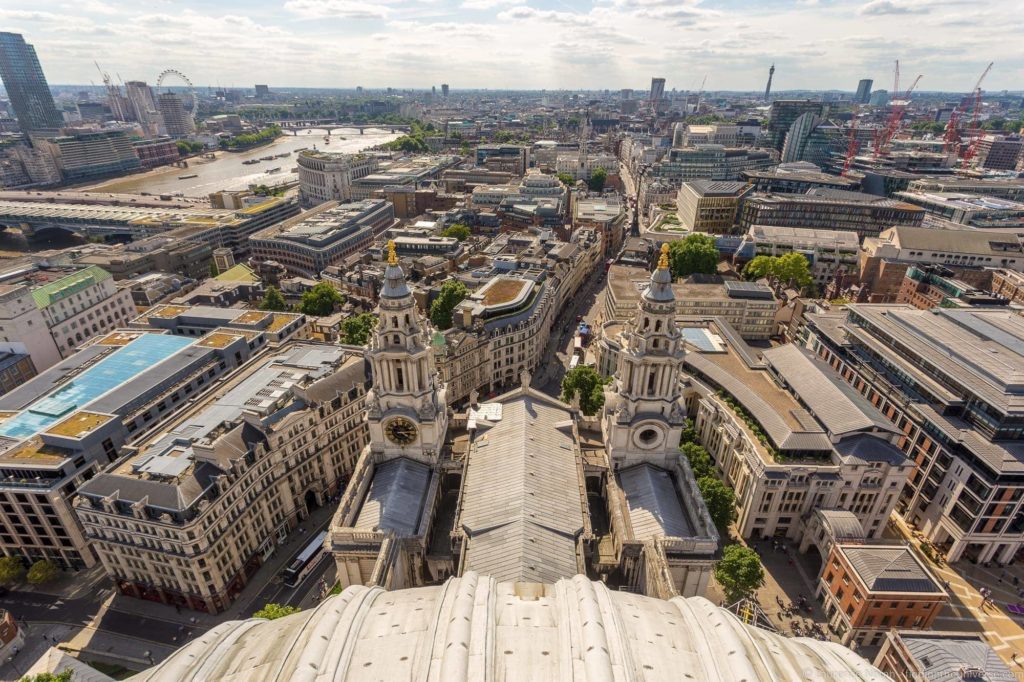
The climate does not vary too greatly across the country, although it is usually a little cooler as you get further north, especially up into northern Scotland.
The key thing with travelling in the UK is to be prepared for anything. The weather in the UK is famous for being fickle, and weather forecasts are notoriously unreliable.
So even in summer you can expect cold, grey days, whilst winter can provide unexpected sunshine and even a little warmth!
Now we’re going to go through our packing list in some detail, after which you’ll find a checklist so you don’t forget anything!
London Packing List
1. clothing.
Generally, for cities in the UK you will find that folks will tend to be fairly well dressed, so you will likely want to pack your nicer looking clothes – although you don’t need to be super dressy for most occasions.
Just bear in mind that if your travel plans include fine dining, nice bars or trips to shows like the opera or the west end then you might want to bring some smarter clothes.
I normally pack a button-up shirt and a light cotton jacket whilst Jess will pack a smart dress.
Clothes for London in Winter
When we travel to London in winter, we usually wear jeans or pants and Jess will wear layers with a warm sweater like this on top , while I will usually have a shirt and a fleece .
We will also both wear a warm winter coat . A warm scarf and good gloves are also essential winter items for London!
In terms of gloves, there are a number of options on the market. These are a good pair specifically designed for photography, with a warm merino wool lining and magnetic finger caps, and are the pair that I own.
However, you’ll find plenty of gloves to choose from if you don’t need a photography specific pair. Our main suggestion is to get a pair with touchscreen capability so you don’t need to take them off to use your phone when navigating or looking up information.
For scarves, we love our cashmere scarves as they are really warm and look great, you can get them for women here and for men here . We have a guide to travel scarves here if you need some more inspiration!
If you suffer from the cold, you will also likely want a warm hat .
Clothes for London in Summer
For visiting London in summer, Jess will usually bring along a pair of pants, capris, and have a light dress with a shoulder wrap to wear depending on the weather.
I usually wear jeans, although on the odd rare hot day I can find that jeans become uncomfortably hot to walk in sometimes, so I will also pack light pants or shorts. For bright days (they do happen, we promise!), you’ll also likely want a pair of sunglasses .
The key thing for either time of year is to bring a series of clothing you can layer so you can adjust to the climate accordingly.
As mentioned at the beginning of the post, if you are doing anything more formal such as a nice afternoon tea at a nice hotel, you should definitely check the dress code in advance so you are prepared.
You are unlikely to need outdoor gear such as hiking pants or boots for your London trip, although if you are heading out to the countryside for a little while, (perhaps following one of our UK itineraries ), then a good pair of hiking pants will likely be a good addition to your UK packing list.

A decent pair of shoes can make or break a holiday. You’re going to be doing a fair bit of walking as you explore the UK and her cities, and the last thing you want is sore feet or blisters.
Recently, we’ve been loving travelling in our Allbirds shoes (see our detailed Allbirds review here ). For cool weather, we like the Allbirds Wool Runner Mizzles , and for warmer weather the Allbirds Tree Runners . The Tree Runners are the most comfortable travel shoes I’ve ever worn, even in very hot weather exploring hot European cities in summer.
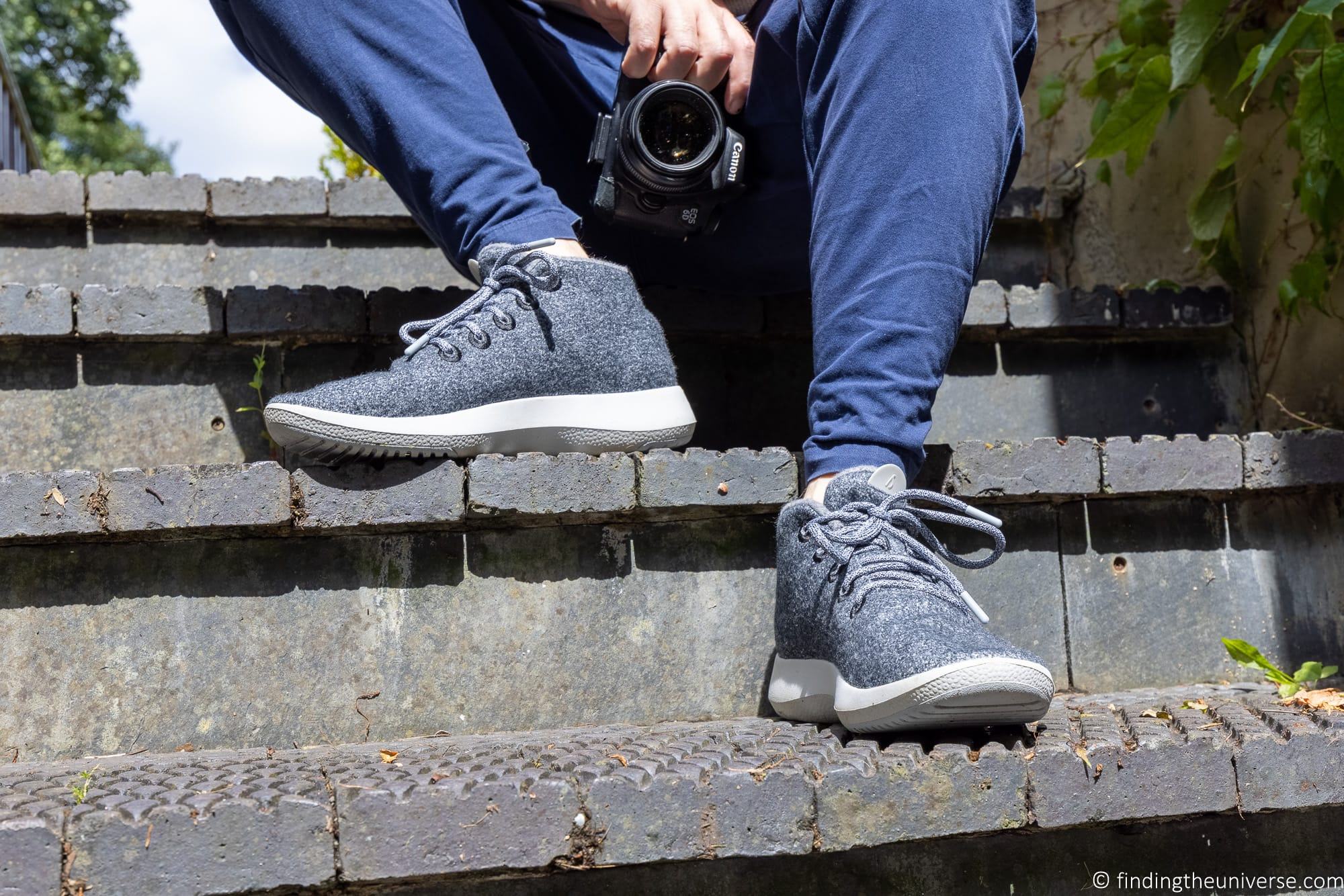
Of course, sometimes you want something a little bit smarter. In that case, I have a pair of Timberland shoes that I love.
They are dressy enough for a night out or a nice meal, but also comfortable enough for walking in all day. They’re also 100% waterproof, which can be a real benefit, as rain showers can happen at any time in the UK!
For slightly more formal situations, Jess loves her versatile black Rockport shoes. Whatever shoes Jess wears though, she finds she suffers from arch pain, probably because of high arches. After a lot of research, we settled on these cool insoles , which have solved that problem.
For more shoe tips, check out our guide to the best travel shoes for men and the best travel shoes for women for tips on picking a great pair to travel in.
3. Toiletries / Make up
Naturally you’re going to want to bring your toiletries with you on your trip to London!
You don’t need much different for London and the UK than anywhere else, so just remember your essentials – toothbrush, toothpaste, deodorant, moisturizer, travel razor and any make-up or sanitary products that you might need.
Of course, all these things are easily available to buy in the UK as well, although as brands might differ slightly, if there is a product you love from home it is best to bring it with you to be sure. If you are on any medication, you should definitely bring this as well.
We’d also advise sunscreen for travel in the summer months, and a good Chapstick for travel in winter as the cold winter air can very quickly dry out your lips which isn’t fun.
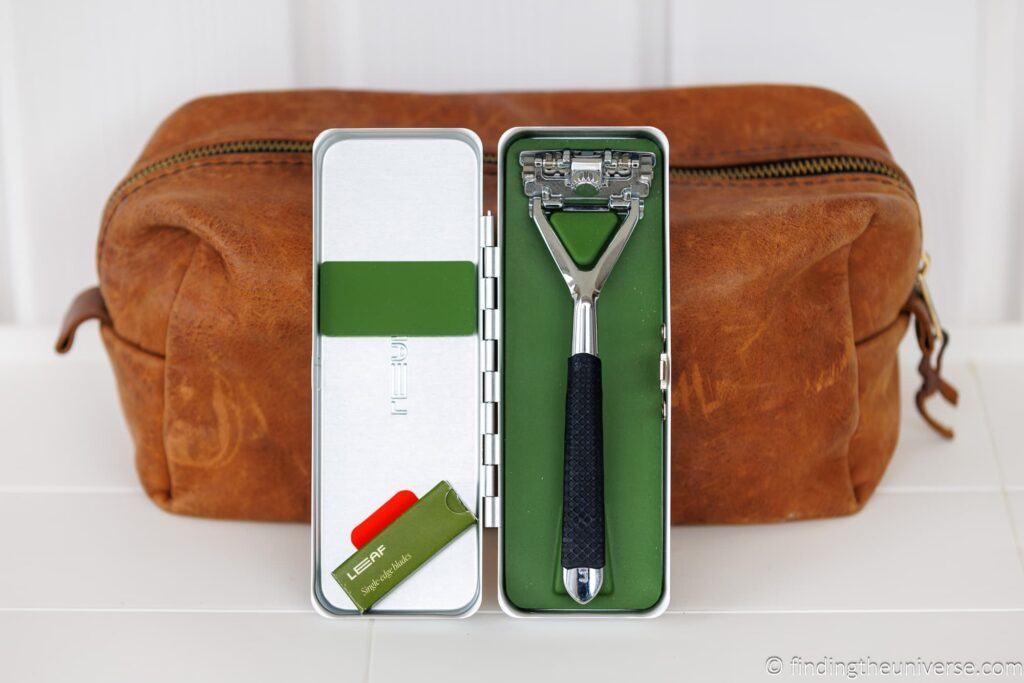
4. Electronic Gear
The UK uses a 220v three pin system, so if you’re travelling from nearly anywhere else in the world you are going to need a travel adapter. We normally use an adapter like this and then pair it with an extension setup like this , which gives us all the plugs and USB ports we need to charge our all devices.
Note that if you are travelling to England from the USA, which uses a 110v system, not all your equipment will work.
Most laptops, phones and cameras will be fine, but in our experience, many hair dryers, curling irons, and hair straighteners don’t support dual voltages. You can check on the plug or in the manual to find out.
Jess has a dual voltage hair dryer and a dual voltage hair straightener for just this reason.
See more on travel adapters and how to choose one for your trip in our guide to the best travel adapters .
You will also of course want your smartphone. If you have an unlocked phone, the cheapest way to get online will be to pick up a SIM card on arrival, or if you want to be fully prepared you can order one in advance . SIM cards are easy to come by in the UK and data is cost effective.
See our advice on getting online when you travel for tips on the best options.
If you’re thinking of a new smartphone for your trip, check our guide to the best cameras for travel , which has a section on smartphones that are good for travel and taking photos.
We would also recommend you travel with an external powerpack to keep everything charged, and a set of decent noise cancelling headphones can be a life saver if you want to watch a movie or listen to a bit of music.
If you like to read, you may also want to travel with a table or e-reader like a Kindle . For most trips you probably won’t need a laptop, but of course if you find it easier to travel with a laptop or tablet then bring one by all means!
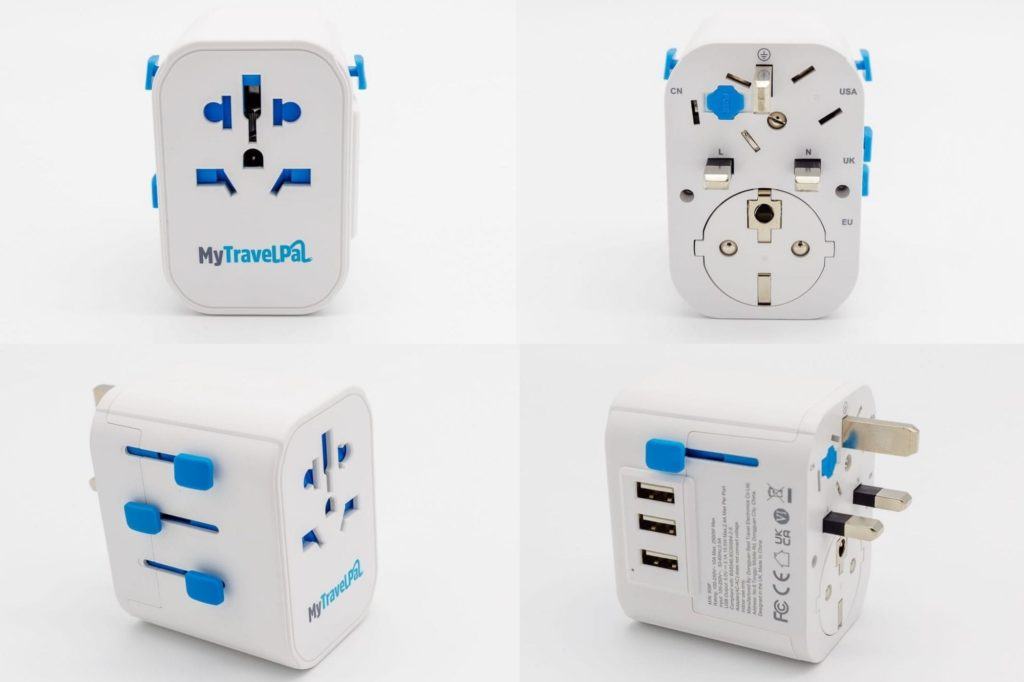
5. Photography Gear
London is a very photogenic city (see my guide to the best photography locations here for some ideas), so you’re definitely going to want to bring some kind of photography gear with you on your trip. Even if that’s just a smartphone!
Our photography setup is likely overkill for most, but if you want to get the best photos, then we advise investing in a dedicated camera and ideally a tripod. See our guide to why you need a tripod for suggestions on the best travel tripods.
We also travel with a selfie stick to get nice photos of the two of us together if we don’t want have time or space to set up the tripod.
Don’t forget when travelling with your camera to bring a few accessories. We’d advise spare batteries, spare memory cards, a UV filter for the lens, and a decent bag or case to keep it all safe. If you don’t get a dedicated camera bag, a camera insert that goes inside your daypack or carry-on is a wise investment.
We also travel with a number of large Ziploc bags which can be really handy to put electronics and wet clothes in should the weather turn bad.
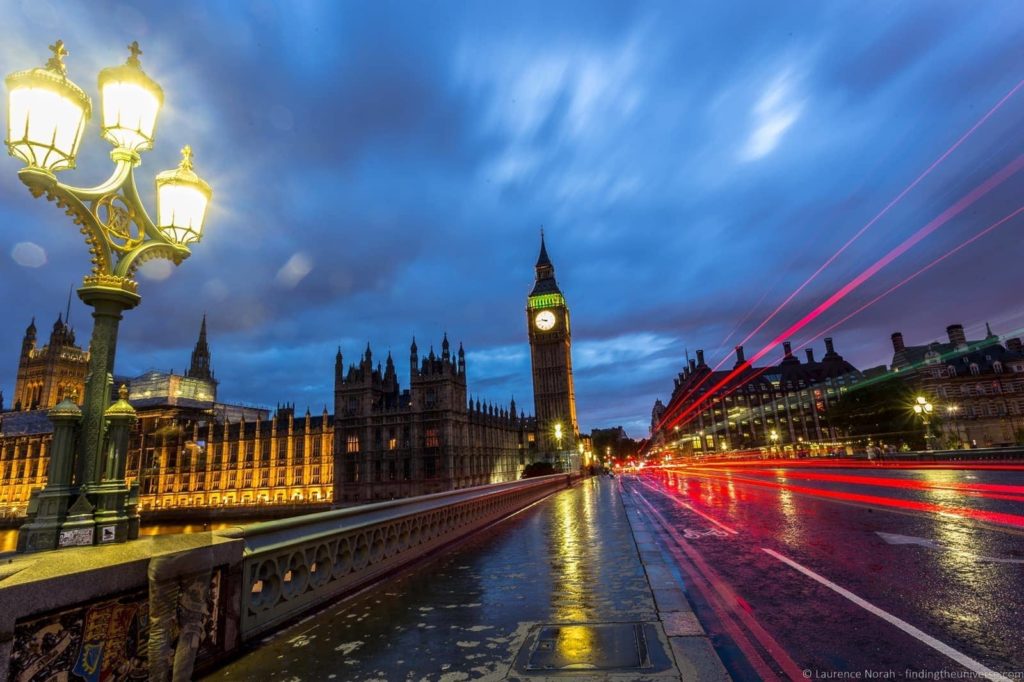
6. Luggage & Backpacks
Picking the right luggage for you is a big decision. The right bag should last you for many years of travel, and suit your particular style – be that carry-on only or checked luggage.
We travel with a fair amount of gear, so we invariably have one checked bag each, and then one piece of hand luggage which has our high value items in. One tip I learnt from my mum’s years of travel wisdom is to split our belongings across our two checked bags – that way if one of them doesn’t make it, we still both have clothes!
For my camera and electronic gear, I currently use a Vanguard Alta Sky 49 , which works well as both a carry-on and a day pack. Prior to that, I used an Osprey day pack with a camera insert, which was also super comfortable.
Jess loves her Eagle Creek bags , and has both a carry-on sized backpack and a larger wheeled backpack that we check-in. For a long time my main checked bag was an Osprey Sojourn 60 . This travelled with me from 2013 until 2021 through multiple countries and countless baggage handlers, and never let me down.
Currently though, we travel with two main checked bags. We have a Level8 trunk bag , and a Delsey Hardside bag . We picked luggage with four spinner wheels as it’s honestly so much easier to move around, and both these bags have survived the rigours of travel very well, including a five week African safari, which is tough on any bag!
If you’re in the market for a new bag, we have no hesitation recommending Eagle Creek , Osprey , Level8 , Delsey and Vanguard as great choices.
7. Reusable Water Bottle
We highly recommend bringing a reusable bottle for water with you so you can fill it in sinks and water fountains and not need to pay for drinks or purchase bottled water. Tap water across the UK is safe to drink, so there’s no need to spend money on water.
If you need to get a water bottle for your trip, we personally like the Klean Kanteen bottles like these .
We have a few different sizes and find the anti-leak lids and easy washability make them perfect for travel. You’ll be saving money and creating less plastic waste, which is always a good thing!
8. Miscellaneous
Obviously, there are a few items you need to bring with you when travelling to the UK, such as your passport. Depending on where you are coming from, you might also need proof of onward travel, a visa, and proof of funds for your time in the UK.
Check the UK government website here to get an idea of what documentation you might need.
We’d also advise having a note of your hotel address available in non-electronic format, as you may need this during immigration proceedings.
Beyond the documentation requirements, don’t forget all the cables for your electronic devices. You are unlikely to need a towel for travel in London and the UK unless you are staying in particularly budget accommodation like backpacker hostels or some of the more budget hotel options that charge for add-ons like towels.
We would recommend you bring a travel umbrella or a travel poncho – these can be very useful in London and the UK as rain can happen at pretty much any time! You can also buy these at many shops in London although the quality might not stand the test of time.
If you would like to keep track of your adventures, we also recommend bringing along a travel journal. We always journal our travels so we can remember what we have seen and done. See our guide to the best travel journals for some ideas.
For London, we can also recommend the Streetwise Map , which is handy for helping you get around. We also recommend a physical guidebook, either the latest Rick Steves London guide , or the Lonely Planet London guide .
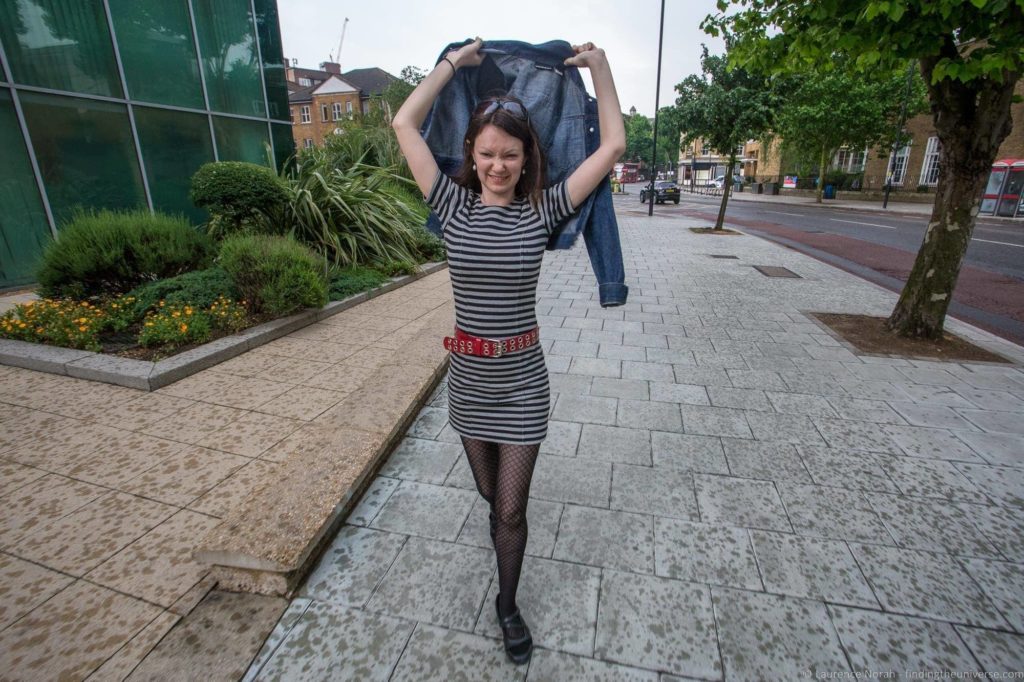
London Packing Checklist
Here’s a full list for you to use as a reminder for your trip to London. You can also download this London packing list in PDF form to print off here .
- Shirts / t-shirts
- Sweater / fleece for layering
- Jeans / Pants
- Underwear / socks
- Shoes (bring a pair that is versatile so you can travel with just one or at most two pairs)
- Swimwear (if needed, such as hotel has pool for instance)
- More formal wear (if needed, such as planned fine dining or theatre experience)
- Warm winter Coat
- Additional Sweaters/ Fleece
- Short sleeve t-shirts / tank tops
- Spring/Summer skirts/dresses
- Capris / Shorts
- Light jacket / sweater
- Sunglasses / hat
- Reusable water bottle
- Toothpaste / toothbrush
- Deodorant/Fragrance
- Moisturiser
- Medications
- Hygiene Products
- Other __________________
- Tripod / selfie-stick
- Memory cards
- Spare batteries
- Camera accessories
- Portable power pack
- Travel adaptor
- Extension lead
- Laptop / tablet / e-reader
- Checked bag
- Carry-on bag
- Visa / proof of onward travel etc (if required)
- Travel towel (backpackers only)
- Jewelry / watch
- Travel journal / reading materials
- Cards / games
- Travel umbrella or poncho
- Other ___________________
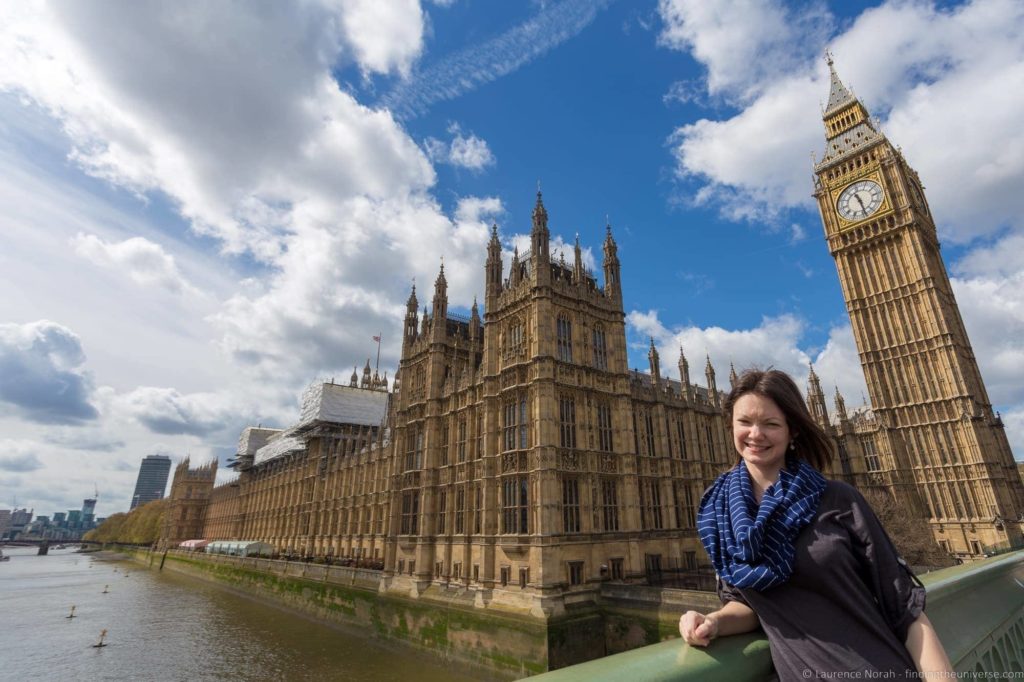
Further Reading for your Visit to London and the UK
We have written many guides that will help you plan and prepare for your trip to London, plus we have some other go-to resources we think you will find useful.
- To help you plan your time in London effectively, check out our itineraries for 1 Day in London , 2 Days in London , 3 Days in London and 6 Days in London
- If you’re flying into London, see our post on advice on getting to London from the airport, which includes detailed information for all six of London’s airports
- Getting around can be a bit daunting on your first visit to London. See our guide to public transport options in London , as well as our overview of how to buy and use an Oyster card to help get prepared
- We have detailed guides to visiting the Tower of London and the London Eye which includes information on planning your visit and how to save money on these popular attractions
- If you’re a Harry Potter fan, you’re going to want to take a look at our guide to the best Harry Potter locations in London
- We have a complete guide to the best food tours in London , which also details all the food and drink you might consider trying when in the capital
- We have a complete guide to where to stay in London , with over 60 recommendations across all the main areas in London we recommend.
- Fans of Winston Churchill will want to see our detailed guide to seeing all London’s Winston Churchill sights
- Military history buffs will want to check out our guide to London’s Best Military Museums and Memorials
- London has four UNESCO world heritage sites, we have a guide to visiting all of them here
- If you want to get the best photos during your time in London, see my guide to the best Photography Locations in London
- We have a full guide to some of the best walking tours in London , which is also worth reviewing if you are interested in a walking tour while you are in the city.
- Many of London’s attractions are quite expensive, so if you plan on doing a lot of sight-seeing, you can save money with a London Pass . See our full review of the London Pass here to see if it will save you money on your trip
- If your visit to London is part of a wider trip to the UK, check out our detailed 1 week and 2 week UK itinerary posts for inspiration
- For accommodation, we recommend Booking.com. See all their London listings here
- The Eyewitness Travel Guide to London , which has all sorts of information within, including more itineraries and ideas for your trip
- Rick Steve’s London guide, the #1 bestseller on Amazon for UK travel guides, and always an excellent source of relevant information
And that’s it for our detailed packing guide for London, which hopefully covers everything you need to know for what to pack for London and the UK in general!
As always, we’re happy to take your questions and feedback – just leave us a comment below, and we’ll get back to you as soon as we can. Safe travels!
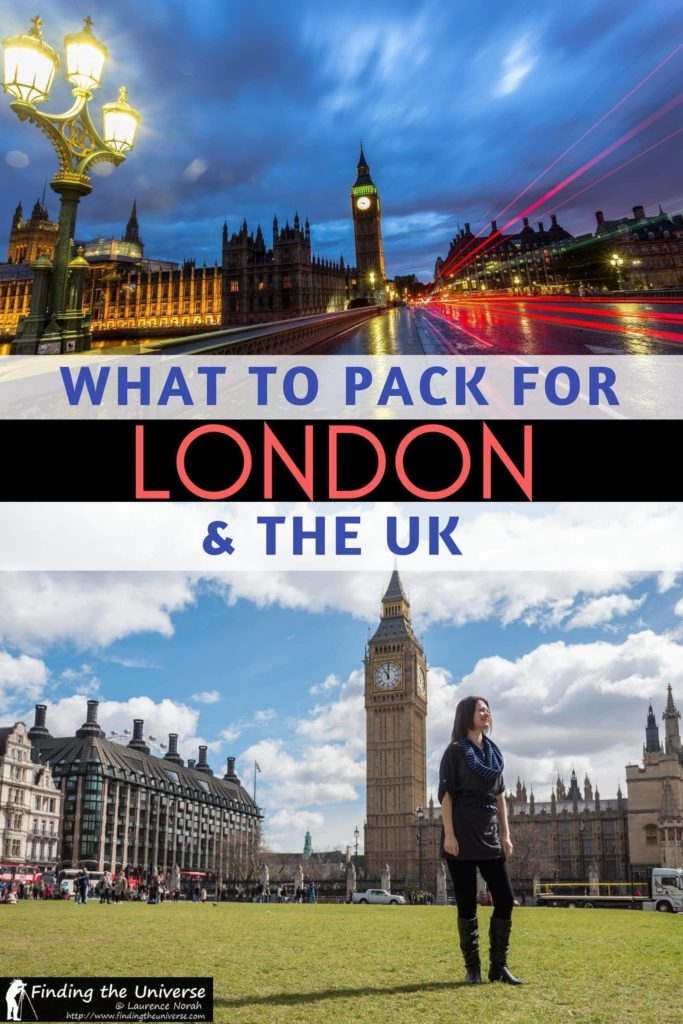
Enjoyed this post? Why not share it!
There are 29 comments on this post
Please scroll to the end to leave a comment
Prashuk says
12th September 2023 at 7:28 am
Your London packing list is incredibly helpful for travelers! Packing for varying UK weather can be a challenge, and your guide covers all the essentials. Thanks for making trip planning easier
Laurence Norah says
12th September 2023 at 9:29 am
It’s my pleasure Prashuk, have a safe trip to the UK and let me know if you have any questions!
23rd April 2022 at 3:09 pm
Thank you for your blog! We leave next week for 3 week driving tour in UK, & then 1 week in London (car-less) before returning to US. We are bringing iPad & iPhone, Roku streaming stick for evening Prime Video/Netflix/YouTubeTV in the airbnbs, & wired adapter(lightning to hdmi) to connect to bigger screens when they are available. What should we buy/bring to adapt those items for UK use? Thanks!
23rd April 2022 at 3:17 pm
So all you should need is some kind of adaptor to convert a US plug socket to a UK plug socket, also known as a travel adaptor. I have a guide to travel adaptors here , but most people opt for something simple like this .
I say should because in my experience most lower power electronics like iPads, iPhones and laptops are already capable of handling the voltage difference. As you probably know, the UK uses 220-240v power, whilst the US uses 110-120v. If you look on the plug or adaptor for the device, it should tell you what the input voltage if accepts is. If it’s in the range of 100v – 250v, or therabouts, it should be fine. However, if it’s fixed around 110 – 120v, it will not work and would in fact be dangerous to try plugging it in to a higher voltage output.
Other than the power adaptor so you can charge your devices, the rest should work fine. HDMI and USB ports are the same around the world, so that should all just work as expected.
Let me know if this makes sense or if I can help any more, and have a great trip to the UK!
Eddie Moricle says
21st April 2022 at 3:38 pm
Thanks for the Info. We are headed to London next month for 8 days!
21st April 2022 at 3:43 pm
My pleasure Eddie, have a great trip!
su Hal says
29th November 2021 at 1:47 pm
hello is it ok to bring cooked from in a container from India ie chicken curry on a flight.
29th November 2021 at 11:23 pm
This might be possible, but it will depend on the quantity of the food and also whether it is very liquid, in which case it may be classified as a liquid which has to then meet the airline requirements. If in doubt, it’s best to reach out to the airline. In addition, if you plan to bring it into the UK you will need to check the regulations in the UK as to what you are allowed to bring in.
Have a great trip to London!
vertoe says
14th November 2021 at 12:22 pm
Great blog! Thanks for sharing informative content with beautiful pictures.
14th November 2021 at 12:26 pm
My pleasure!
Elyonda Mckenzie says
30th May 2021 at 1:47 am
Hi, I’m going to London the last week of September and first week of October, how heavy of a coat should I take. I’ll be in Paris the first week of October. Thanks
31st May 2021 at 8:27 pm
Hi Elyonda! Great question. I’d say a medium size coat. At that time of year you’re looking at temperatures probably between 12C (53F) and 20C (68F). So it shouldn’t be too cold, however rain is always a possibility. So I’d recommend a waterproof coat but it shouldn’t need to be too thick 🙂
Have a great trip!
Renee Cundy says
5th December 2019 at 5:24 am
I booked a visit to London for end of summer 2020, this site is very helpful & informative, so thank you for that. I am a huge fan of the band Queen & plan to seek out any & every place associated with them that I can find while I’m there. Would love it if you could add a link among your other places of interest that would include “A guide to all things Queen related”. I don’t want to miss a thing on my once in a lifetime trip to London.
5th December 2019 at 10:35 am
Thanks very much for your comment 🙂 I do like the band Queen, but I am definitely not an expert! However, if you search for Queen locations in London, a number of helpful results come up which should help in your search 🙂
Kathy Draper says
29th June 2019 at 8:24 pm
Excellent and clear information (especially about how to handle cell phone decisions while in Britain). Thanks much!
29th June 2019 at 8:29 pm
Thanks very much Kathy – have a great trip to the UK, and do let us know if you have any questions!
Betsy Kerr says
27th March 2019 at 3:27 pm
FB Messaged you: First-time overseas travelers going to Scotland and England (Edinburgh area and London) in late July-August. Saw USA Today article regarding attire that said, “First, unless the sun shines and the temperature rises into the 80s, it’s fairly rare to find an Englishman in shorts. However, schoolboys under age 13 may wear long shorts with knee-high socks all year-round, typically as part of a school uniform.” Fine for Englishmen but what about male tourists? Or female tourists for that matter? Do they wear shorts? Thanks! Betsy Kerr
27th March 2019 at 5:18 pm
You’re welcome to wear shorts whenever you like! I’m not sure that USA Today article is exactly representative of reality today 😉 If it’s a warm day, we wear shorts over here too. It’s just not warm as often as we’d like, and shorts aren’t something you would see as business attire, but certainly, if you’re on holiday shorts are perfectly acceptable attire!
27th March 2019 at 5:22 pm
Thank you! Don’t want my hubby to stand out like a sore thumb! 🙂
Pam Heathcote says
11th January 2019 at 10:40 am
Off to London for the first time since primary school ( now in my 60s). Have found your website very helpful, not only for packing advice but also for the photography tips. Many thanks Pam
11th January 2019 at 10:57 am
Our pleasure Pam. Do let us know if you have any questions, and have a fantastic trip!
Ryan Jones says
5th January 2019 at 5:58 am
Just wondering about the travel adapter and extension. Coming from the US to the UK will I need a power converter to bring the power down from 220v to 120v or will a travel adapter and power strip work?
5th January 2019 at 10:52 am
So it really depends on your electronics. In our experience, most smaller electronics like laptops, camera chargers and so on are rated for both 110v and 220v, so all you would need is the adapter and power strip. However, you definitely need to check each device – the voltage it accepts will be written on the charger part somewhere.
Higher power devices usually are not dual voltage, in our experience this includes things like hair dryers and straightening irons. There are travel versions of these devices available which support two voltages, but it’s not a standard.
Usually a power convertor isn’t necessary, and in our experience they tend to be fairly bulky, so best avoided if possible – it’s best to get a travel version of the device instead in our opinion if one exists.
Hope this helps!
Timothy Aull says
6th November 2018 at 5:19 pm
I was fortunate enough to live in London for three months as a study abroad student while I was in college. I am now headed back to London for my honeymoon. Just wanted to say that I have found your website a great resource for planning my wife’s first trip to London. Thank you for such a wonderful source for those who love to travel and explore new things.
7th November 2018 at 4:02 pm
Hi Timothy!
What a lovely comment, thank you so much for taking the time to stop by and let us know. It’s always wonderful to hear from readers that we are able to help them, and we hope you and your wife have a wonderful trip to London (we’re actually in London as I type this, investigating all the latest attractions and ensuring our content is all up to date!)
Barbara says
17th June 2018 at 1:24 am
Thank you very much for this list – I’d forgotten ziploc bags – great item to pack!
17th June 2018 at 11:52 pm
Thanks Barbara – they are very useful for all sorts of things 😀
7th June 2018 at 1:38 pm
Thanks for taking the time to create this blog . . . headed to London next month and you have provided some information and tips!
8th June 2018 at 10:29 am
Our pleasure Peter – have a great trip!
Leave a Reply Cancel reply
Your email address will not be published. Required fields are marked *
Let me know when there's a reply to my comment (just replies to your comment, no other e-mails, we promise!)
Subscribe to our monthly Newsletter where we share our latest travel news and tips. This also makes you eligible to enter our monthly giveaways!
We only ask for your e-mail so we can verify you are human and if requested notify you of a reply. To do this, we store your data as outlined in our privacy policy . Your e-mail will not be published or used for any other reason other than those outlined above.
Get Daily Travel Tips & Deals!
By proceeding, you agree to our Privacy Policy and Terms of Use .
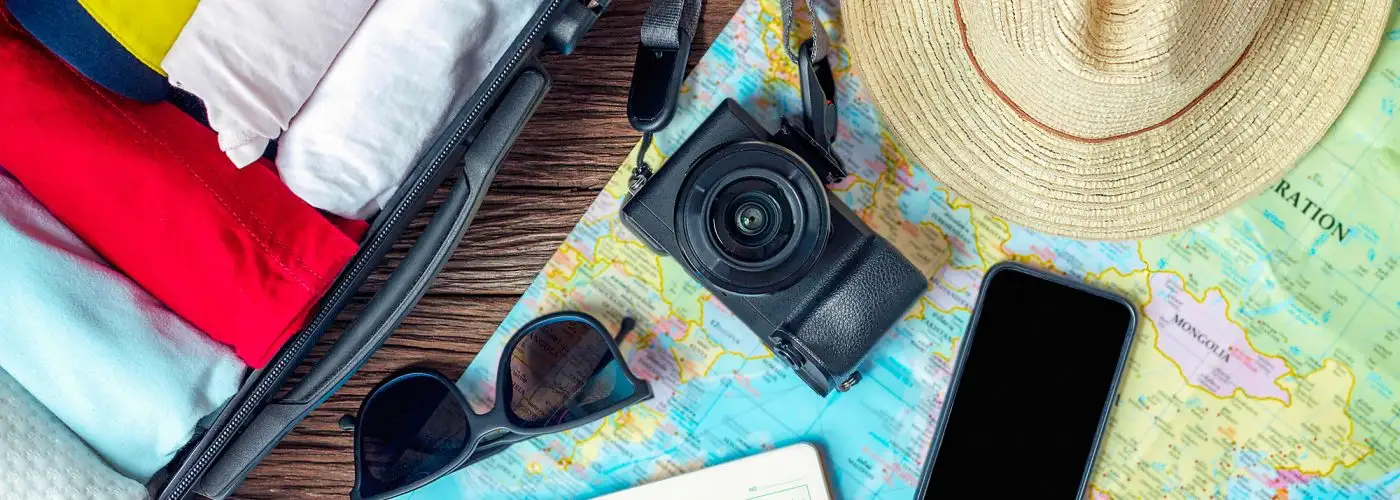
The Ultimate Packing List
Christine Sarkis
Ashley Rossi
There's a 95 percent chance Senior Editor Christine Sarkis is thinking about travel right now. Follow her on Instagram @postcartography and Twitter @ChristineSarkis .
Christine Sarkis is an SATW-award-winning journalist and executive editor at SmarterTravel. Her stories have also appeared on USA Today, Conde Nast Traveler, Huffington Post, and Business Insider. Her advice has been featured in dozens of print and online publications including The New York Times , Conde Nast Traveler , and People magazine. She has also shared travel tips on television and radio shows including Good Morning America, Marketplace, and Here & Now. Her work has been published in the anthologies Spain from a Backpack and The Best Women's Travel Writing 2008 . She is currently working on a travel memoir.
The Handy Item I Always Pack : The Trtl Pillow . It's easy to pack and comfortable, and makes it so I can actually sleep on flights.
Ultimate Bucket List Experience : Seeing the Aurora Borealis from the comfort of somewhere warm, like a glass igloo or hot spring.
Travel Motto : Curiosity is an amazing compass.
Aisle, Window, or Middle Seat : Aisle all the way.
Email Christine Sarkis at [email protected] .
Ashley Rossi is always ready for her next trip. Follow her on Twitter and Instagram for travel tips, destination ideas, and off the beaten path spots.
After interning at SmarterTravel, Ashley joined the team full time in 2015. She's lived on three continents, but still never knows where her next adventure will take her. She's always searching for upcoming destination hotspots, secluded retreats, and hidden gems to share with the world.
Ashley's stories have been featured online on USA Today, Business Insider, TripAdvisor, Huffington Post, Jetsetter, and Yahoo! Travel, as well as other publications.
The Handy Item I Always Pack : "A reusable filtered water bottle—it saves you money, keeps you hydrated, and eliminates waste—win-win."
Ultimate Bucket List Experience : "A week in a bamboo beach hut on India's Andaman Islands."
Travel Motto : "Travel light, often, and in good company."
Aisle, Window, or Middle Seat : "Window—best view in the house."
Travel Smarter! Sign up for our free newsletter.
Packing mishaps range from inconvenient (heading to the Caribbean without a swimsuit) to disastrous (discovering you left the country without your wallet), but most are preventable. We’ve created this ultimate packing list to help you pack well every time.
The Ultimate Packing Checklist
To see the ultimate packing list, scroll down the page or click here for an editable PDF version that you can save or print out. To customize the list, simply download or print it, then edit for your specific needs. You can also download the editable, mobile-friendly checklist here .
Clothes to Pack
- Dress Shirts
- Casual Shirts
- Sweatshirts
- Laundry Kit
- Leisure Shoes
- Hiking Boots
- Dress Shoes
- Collapsible Tote
Shop Our Clothing Packing List
Toiletries to Pack
- Dental Floss
- Conditioner
- Styling Tools
- Facial Cleanser
- Face Lotion
- Moisturizer
- Contact Lenses
- Contact Solution
- Shaving Supplies
- Makeup Remover
- Menstrual Products
- Birth Control/Medication
- Nail Clippers
- Hand Sanitizer
- First-Aid Ointment
- Insect Repellent
- Pain Relievers
Shop Our Toiletries Packing List
Miscellaneous Items
- Laptop/Tablet
- Film/Memory Card
- List of Medications
- Banking Contacts/Information
- Electronic Chargers
- Emergency Contacts
- Copy of Passport
- Plug Adapter
Shop Our Miscellaneous Items List
What to Pack in Your Carry-on
- Books or E-Books
- Travel Blanket
- Travel Pillow
- Disinfecting Wipes
- Change of Clothes
- Empty Water Bottle
- In-Flight Medications
- Passport/Visa/ID
- Credit/ATM cards
- Insurance Cards
- Maps/Directions
Shop Our Carry-On Essentials List
Packing Tips for Clothes and Other Items
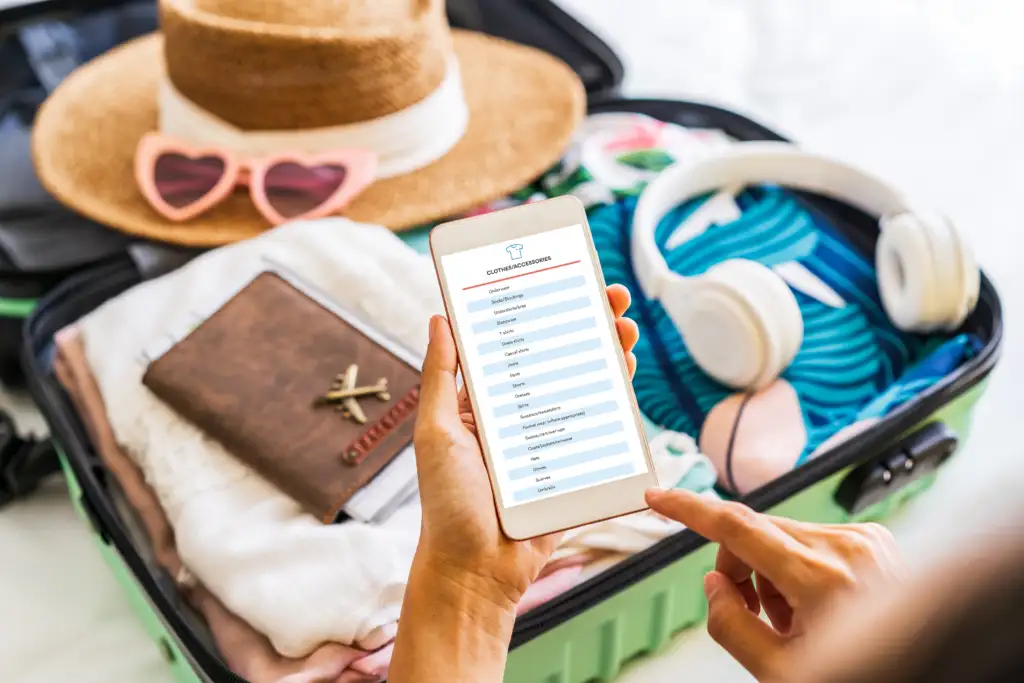
When packing for a vacation the most important things to keep in mind are the length of your trip, the weather, and any non-standard clothing or gear you might need.
Your first step when packing is to decide if you’ll be checking a bag or only taking a carry-on and then curate the amount of clothing you’ll need based on that decision. Typically, you should avoid checking a bag in situations where you have a layover since the likelihood of your bag going missing goes up with every connection . You might also want to avoid checking a bag if you absolutely need items in your bag on arrival—for example, if you’re going on a cruise.
If you’re packing more minimally, focus on packing layering clothes in more neutral colors. That’s not because we don’t like fun colors and patterns; it just means that neutral-colored clothing is more versatile, so you can wear these items more than once when you’re tight on space.
How to Pack in Just a Personal Item Sized Bag
Also invest in clothing that does double duty, like multi-use wraps , crushable hats , self-cooling and heating fabrics like merino wool layers , bug-repellent clothing , wrinkle-resistant shirts, quick-drying activewear and undergarments, casual sneakers, UPF-proof clothing , and compressible jackets … just to name a few. Look toward popular athleisure brands like Lululemon , prAna , and Athleta for comfortable yet stylish travel clothing.
When curating your packing list, you should keep in mind the length of your trip and decide on quantities from there. For a shorter trip (three to five days), you can probably manage with the following: one pair of underwear and socks per day, one pair of pajamas, one to two dressier outfits, one to two activewear or athleisure outfits, one to two casual outfits, and one to two pairs of shoes. For a longer trip (over a week), you can manage with one pair of underwear and socks per day, two pairs of pajamas, three dressier outfits, three to four casual outfits, two pairs of shoes, and two activewear or athleisure outfits.
And if you’re able to do laundry on your vacation, you can probably manage with even fewer items. Just don’t forget to pack a travel laundry kit .
Scrubba Untouched Review
Also make sure to bring along accessories like a money belt, scarf or sarong (can be used for things like an airplane blanket , coverup at the beach, or to throw over your dress on a cool evening), and a collapsible tote or day bag for any extra items you might acquire on your travels. If traveling to a city or destination that is prone to pickpocketing, make sure to pack some pickpocket-proof clothing and gear .
Depending on the type of trip you’re going on, you may need to invest in some special travel gear. We’ve tested out everything from waterproof baby carriers to interchangeable heels , so you can trust our recommendations. If you’re headed out on an organized group tour , you’ll most likely get a packing list from the tour provider, which should make your trip planning easier. If not, do your research online (one tip is to look at locations on Instagram and see what people are wearing) and consult this story for other handy lists of tips.
For more active trips, make sure you have a sturdy pair of hiking boots, quick-drying clothing, a day pack, snacks, and any necessary equipment. Check out our specific packing lists for hiking trips and camping trips .
Another type of trip that you may need to pack slightly specific items for is a cruise . Make sure you pack non-standard items like seasickness remedies, formal wear, dress shoes, and your bathing suit. Beach vacations also require different items like water shoes, towels, sunscreen, and maybe even snorkel gear. Luckily for you, we also have a specific cruise packing list and a beach vacation packing list .
Lastly, you need to consider the weather. For warm-weather destinations like jungles and Caribbean islands, you can obviously skip the coats and gloves, but if you’re headed out on a ski vacation then you’ll need a whole slew of things like goggles, a neck gaiter, snow boots, and more. But don’t worry, we’ve got you covered with a specific Caribbean vacation packing list , a Mexico vacation packing list , and even a ski trip packing list .
10 Secrets I Learned Working in a Hotel
To help keep things organized, we love using packing cubes and/or compression sacks. They’re especially useful for when you’re traveling to multiple destinations in one trip.
Wondering how to pack all of your items? Enter the great debate of the rolling vs. folding method! While this is definitely a personal preference, we put two editors to the test to find out which method is in fact, more space-saving. Watch the video below to see the answer.
How to Pack Toiletries and Medications
Whether it’s important medication or your favorite lipstick, forgetting any type of toiletry can range from being mildly inconvenient to becoming a serious problem. For toiletries, make sure to pack your essentials, like medication, contacts, and any other items that you might not be able to purchase or replace during your travels. (Put them in your carry-on bag, not your checked suitcase.) However, if you forget items like a toothbrush or razor, you can typically call the front desk at the hotel for a spare.
We also recommend traveling with some type of a travel first-aid kit , which includes items like tweezers, first-aid ointment, bandages, travel-sized hand sanitizer, sunscreen, and insect repellent. Make sure to check TSA guidelines if you’re traveling with medication , as well as the policies and regulations at your destination.
Packing Tips for Everything Else …
Traveling without tech items like your phone, laptop, tablet, or camera can be a major bummer. For those traveling abroad, you’ll also want to remember to pack electronic adapters and converters . Other tech-related items for photographers to pack are a sturdy camera bag , backup batteries, and memory cards, as well as lens cleaner. And don’t forget smartphone essentials like a backup charger, waterproof case if you’re headed out on the water, and a phone stand or tripod for photos.
A travel packing tip we’ve learned the hard way? Travel with a copy of your passport, credit card, and bank contacts, as well as a list of medications and your emergency contacts.
If you are traveling abroad, we have an entire checklist for you, but the most important thing to note here is your passport and visas . Make sure that your passport is up to date, has as least six months of validity, and has enough blank pages for any stamps. Another tip for international travel? Give yourself plenty of time to apply for any visas that you might need and to arrange for a visit to a travel clinic if any special medications or vaccines are needed. You should also familiarize yourself with any remaining COVID-19 travel restrictions at your destination.
There are also some items that you may not think to pack, but should, like an electronic tracker , duct tape , toilet paper, a decoy wallet, or a whistle.
The 10 Best Expandable Suitcases
What to Always Pack in Your Carry-on Bag
In case you’re separated from your checked bag or other items, you should always make sure that you have your ID, wallet, house keys, medications, valuables, camera, phone, laptop, tablet, pen, cash and cards, glasses, and copy of your itinerary with you on the plane.
Other items that you might want to have handy with you include entertainment for your flight, comfort-promoting items like a blanket or pillow, as well as an empty water bottle to fill up post-security (here is a list of our favorites ), a change of clothes (just in case your luggage is lost or delayed), snacks, and gum.
If you’re looking to pack carry-on only, you guessed it: We also have a separate packing list and tips for that, as well as the best bags to use for carry-on only .
What to Pack to Stay Healthy While Traveling
The pandemic has significantly changed the way we travel and, by extension, the items we prioritize in our luggage. While many destinations have loosened or entirely lifted COVID-19 restrictions, some venues and events may still require a mask or proof of vaccination/negative COVID test to enter. Plan ahead to see if any activities on your itinerary have restrictions in place.
Sanitizing wipes and hand sanitizer , while always a good idea to have on hand at the airport , have become absolute carry-on musts. Wiping down areas like your tray table, airplane seat armrest, and hotel television remote can spare you from a variety of common travel bugs.
Editor’s note: This story was originally published in 2013. It has been updated to reflect the most current information. Ashley Rossi contributed to this story.
All of the products featured in this story were hand-selected by our travel editors. Some of the links featured in this story are affiliate links, and SmarterTravel may collect a commission (at no cost to you) if you shop through them. As an Amazon Associate, we earn from qualifying purchases.
You Might Also Like:
We hand-pick everything we recommend and select items through testing and reviews. Some products are sent to us free of charge with no incentive to offer a favorable review. We offer our unbiased opinions and do not accept compensation to review products. All items are in stock and prices are accurate at the time of publication. If you buy something through our links, we may earn a commission.
Top Fares From

Don't see a fare you like? View all flight deals from your city.
Today's top travel deals.
Brought to you by ShermansTravel
Oslo to Bergen: 6-Night Norway Fjords...


Luxe, 7-Night Caribbean & Mexico Cruise...
Regent Seven Seas Cruises

Ohio: Daily Car Rentals from Cincinnati

Trending on SmarterTravel
Security Alert May 17, 2024
Worldwide caution, update may 10, 2024, information for u.s. citizens in the middle east.
- Travel Advisories |
- Contact Us |
- MyTravelGov |
Find U.S. Embassies & Consulates
Travel.state.gov, congressional liaison, special issuance agency, u.s. passports, international travel, intercountry adoption, international parental child abduction, records and authentications, popular links, travel advisories, mytravelgov, stay connected, legal resources, legal information, info for u.s. law enforcement, replace or certify documents, before you go.
Learn About Your Destination
While Abroad
Emergencies
Share this page:
Crisis and Disaster Abroad: Be Ready
What the Department of State Can and Can't Do in a Crisis
Information for U.S. Citizens about a U.S. Government-Assisted Evacuation
Traveler's Checklist
Safety and Security Messaging
Best Practices for Traveler Safety
Staying Connected
Smart Traveler Enrollment Program (STEP)
Traveler Information
LGBTQI+ Travelers
Adventure Travel
High-Risk Area Travelers
Travelers with Dual Nationality
Journalist Travelers
Faith-Based Travelers
Pilgrimage Travelers (Hajj and Umrah)
U.S. Students Abroad
Cruise Ship Passengers
Women Travelers
Travelers with Disabilities
Older Travelers
U.S. Volunteers Abroad
Travelers with Pets
Travelers With Firearms
Travel Agents
Travel Safety - Race and Ethnicity
U.S. Travelers in Europe's Schengen Area
Your Health Abroad
Insurance Coverage Overseas
Driving and Road Safety Abroad
Customs and Import Restrictions
Information for U.S. Citizens in Russia – Travel Options Out of Russia
Lodging Safety
Paris 2024 Olympics and Paralympics
Get Required Documents
Safeguard Your Documents! Make copies of all your travel documents. Leave one copy with a trusted friend or relative and carry the other separately from your original documents. Also take a photograph of your travel documents with your phone to have an electronic copy.
- Passport: Check your passport expiration dates as soon as you start planning a trip, and remember passports issued to children under 16 are only valid for only five years. Some countries – including most of Europe – will require that your passport expiration date is at least six months away. If you need a new passport, apply early to allow for delays; click here for passport information.
- Visas: Check with the embassy of your destination regarding visa requirements.
- Medications: Some prescription drugs (including narcotics) and some U.S. over-the-counter medications are illegal in other countries. Check with the embassy of your destination(s) about regulations and documentation before you travel.
- Consent for Travel with Minors: If you are traveling alone with children, foreign border officials may require custody documents or notarized written consent from the other parent. Check with the embassy of your foreign destination before traveling to see what you may need.
- International Driving Permit: Many countries do not recognize a U.S. driver's license, but most accept an International Driving Permit (IDP). You may also need supplemental auto insurance. Read more about driving and road safety abroad before you go.
Importance of Travel Insurance
- The U.S. government does not provide insurance for U.S. citizens overseas. We do not pay medical bills or unexpected costs. We highly recommend that you purchase travel insurance before you travel to cover emergency medical care, either as part of or separate from trip cancellation insurance.
- Health Insurance: Medical facilities and providers abroad may require cash up front and may not accept U.S. insurance plans. U.S. Medicare/Medicaid does not provide coverage outside the United States. Check your health care policy to see if it will cover you overseas. If not, consider buying supplemental insurance . Make sure the insurance you purchase covers any special medical needs or risks you anticipate on your trip.
- Emergency Medical Evacuation: Evacuation for medical treatment can cost more than $100,000. You should strongly consider purchasing medical evacuation insurance in case of emergency overseas.
Get Informed
- Smart Traveler Enrollment Program (STEP) : Enroll at step.state.gov to receive travel and security updates about your destination, and to help us reach you in an emergency.
- Safety and Security Information: Read the Travel Advisory and Alerts for the countries you will be visiting at travel.state.gov/destination .
- Crisis Planning: Read Crisis Abroad: Be Ready
- Health Precautions: Read Your Health Abroad and check out recommendations for vaccinations and other health considerations from the U.S. Centers for Disease Control (CDC) and World Health Organization (WHO) .
- Money Matters: Before going abroad, notify your bank and credit card companies of your travel, and check exchange rates. For information about using cash, debit/credit cards, and ATMs overseas, read the country information page for your destination .
- Follow us on TravelGov on Twitter , Facebook , or Instagram
Every traveler is unique. Learn more before you travel.
Other Information for U.S. Citizen Travelers
- Information for Travel Agents
- Travel to High-Risk Areas
- Traveling with firearms
- Traveling with a pet
- Travel during tropical storm season
- FBI Safety and Security Information for U.S. Students Traveling Abroad
- Customs and import restrictions
- Global Entry
- TSA Pre-check
Emergency Assistance
Sometimes, in spite of careful planning, things still go wrong during a trip abroad. Contact the nearest U.S. embassy or consulate overseas or our Washington, D. C. office ( 888-407-4747 or 202-501-4444 ).
The Department of State assumes no responsibility or liability for the professional ability or reputation of, or the quality of services provided by, the entities or individuals whose names appear on or are linked to the above page. Inclusion of private groups on this page is in no way an endorsement by the Department or the U.S. government. The order in which names appear has no significance. The Department is not in a position to vouch for the information.
Download the checklist
Download the Traveler's Checklist before you go!
Enroll in STEP

Subscribe to get up-to-date safety and security information and help us reach you in an emergency abroad.
Recommended Web Browsers: Microsoft Edge or Google Chrome.
Learn about your destination
Make two copies of all of your travel documents in case of emergency, and leave one with a trusted friend or relative.
External Link
You are about to leave travel.state.gov for an external website that is not maintained by the U.S. Department of State.
Links to external websites are provided as a convenience and should not be construed as an endorsement by the U.S. Department of State of the views or products contained therein. If you wish to remain on travel.state.gov, click the "cancel" message.
You are about to visit:
- Skip navigation
- Find a branch
- Help and support
Popular searches
- Track a parcel
Travel money
- Travel insurance
- Drop and Go
Log into your account
- Credit cards
- International money transfer
- Junior ISAs
Travel and Insurance
- Car and van insurance
- Gadget insurance
- Home insurance
- Pet insurance
- Travel Money Card
- Parcels Online
For further information about the Horizon IT Scandal, please visit our corporate website
- Holiday packing and pre-travel checklist
So, you’ve booked your flights, accommodation and activities. What next?
Let’s make sure you’re not leaving anything out – from what to book and arrange upfront to the essential items to pack when you go.
Posted: 24/1/2022 | By Amanda Duffy
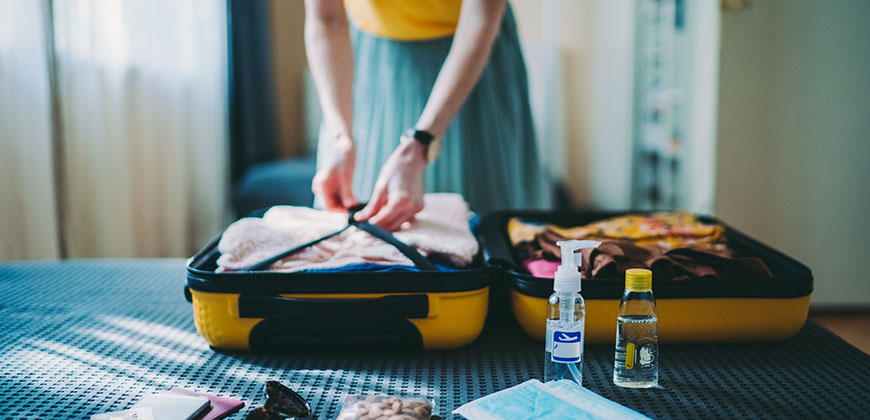
We’ve put together checklists for travel in general and for specific types of holiday too, so you can tick things off easily, wherever you’re off to. With so much else to keep in mind when you’re getting set to travel, checklists can help you avoid forgetting something important.
Before you go
Packing list essentials.
- Checklists by holiday type
There are a few things you should do to get your house in order before you leave for your holidays.
Bills and utilities
- Let your credit/debit card company know you may be using it abroad – it will help avoid problems later
- Pay bills in advance that will be due while you’re away
- Turn off electrical wall sockets (except the fridge and the freezer) if your home is going to be empty
- Set timers for devices or appliances you still want to come on while you’re away, like lights (to put off would-be burglars) or your boiler
- Contact your mobile operator to see if roaming charges apply where you’re going – if they do, discuss your options
Practical tips
- Clear out the fridge of anything that’s going to go off while you’re away
- Find a place for your pets – ask a friend, family member or neighbour to look after them or book with recommended local kennels or catteries
- Let a neighbour know you’ll be away – give them spare keys and emergency contact details just in case
- Book airport parking – paying in advance could help you save money, especially if you book reputable services a bit further away and catch a shuttle bus to the airport
Protect what matters when you go with good travel insurance
Documents and travel insurance, check your passport.
How long is left on your passport? Check in good time for everyone who’s due to travel, in case any are about to expire. Some countries refuse entry to tourists whose passports are less than six months from expiry.
Applying for a new passport can take at least six weeks, while renewing a passport takes three weeks – so don’t leave it to the last minute. Passports can be renewed or replaced at any time.
You should also check well in advance if you need a visa for your destination. The time it takes to apply and receive a visa can vary.
Get travel insurance
Good travel insurance for everyone in your family should be top of the holiday checklist. It can provide extra reassurance as it may cover you for cancellation before your trip, missed or delayed flights, or lost, stolen luggage and other belongings such as passports and cash. Most importantly, it may cover emergency medical costs if you need attention while away.
In EU countries, a Ghic or Ehic will give you free or low-cost emergency and state medical care, but they’re not a replacement for travel insurance . They won’t cover you being airlifted from a mountain or flown back to the UK, or extra accommodation or transport costs for a family member if you need a long stay in hospital. So, it’s best to have your travel insurance in place well before you go and take all documents with you.
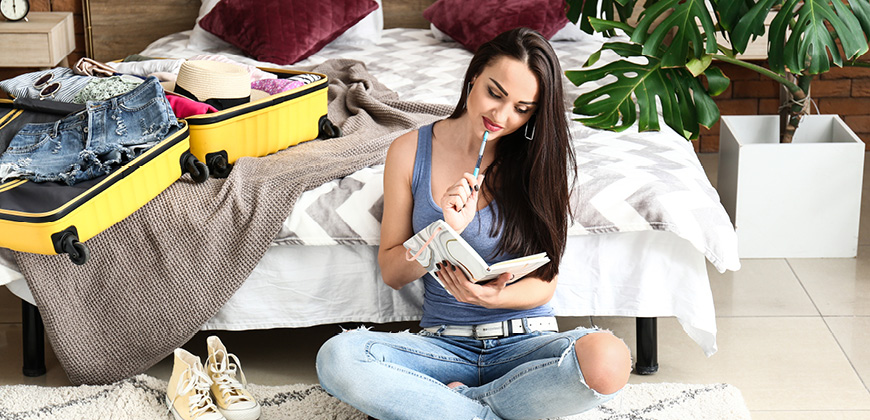
It’s important to have some cash wherever you are going, even if you are visiting a largely cashless place. You never know what you might need it for. So local currency comes high on any holiday essentials list.
Don't pay over the odds for travel money at the airport. Get it sorted as soon as possible, ideally when the pound is strong against the foreign currency you need. Use a currency converter to check the exchange rate.
Make sure you have at least two different debit or credit cards – memorising both PIN numbers. Keep one in a safe place as an emergency backup. Note that some banks charge for cash withdrawals overseas. You can also load travel money onto prepaid travel money cards .
Travel apps are also available that help you keep track of your holiday spending and convert local prices into pounds easily when you’re away.
Your travel itinerary
Find out your flight times, including departure time and when to check in by, and add in plenty of extra time to get to the airport and for unexpected delays.
Check in online the night before if you can and print off your boarding passes, as some airlines charge you to issue a boarding pass at the airport. Print off an extra set and keep them separate, just in case.
Double-check your accommodation check in times. If you get there early, you may need to wait for them to get your room or whatever you’re staying in ready.
Find out if they’ll hang onto your luggage in the meantime – then you can explore without carrying your bags around with you. Just remember to take any valuables with you or ask to leave them in the reception safe.
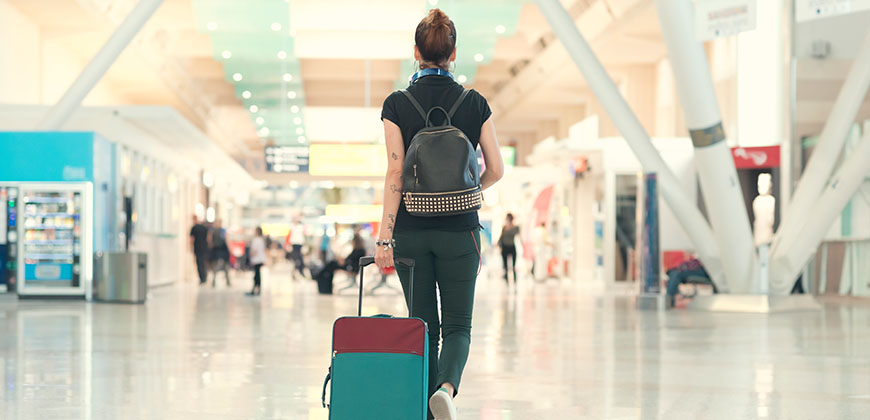
In the following checklists, we cover off the absolute essentials you’ll need wherever you’re going, and whatever type of holiday you’re going on. And we answer the question “what documents do I need for my holiday?”
We haven’t listed clothing – just take what’s appropriate for the climate in your destination and any activities you’ll be doing. And remember to pack a pen and paper – they’ll be useful in all kinds of situations, especially if your electrical gear fails you.
When you’re packing, make sure you know the airline’s weight limits for hand luggage and checked bags. Weigh your luggage on the bathroom scales before you go. If your hand luggage is too big, you’ll have to check it in – and that usually means an extra charge.
Don't forget the essentials
Travel documents.
The travel documents you need in order to be able to travel are:
- Boarding passes
- Visas (if required – print and take with you)
- ESTA (if you’re travelling to the USA – print and take with you)
Take a copy of your passport details in case it gets lost and you need to apply for an emergency replacement . Other important documents for your travels might include:
- Travel insurance documents
- Itinerary details – a list of addresses of where you’ll be visiting and when
- Home address details in the UK
- Contact details for your bank, particularly the overseas contact number
- Any onward travel (such as train) documentation
- Information about the British embassy in the country your visiting, or your nearest consulate
- Travel agency contact details if relevant
- Ghic or valid Ehic for EU trips (see ‘health and medication’ below)
- Driving licence (as a form of ID whether you’ll be driving or not)
- International Driving Permit (IDP)
- Hire car details
- Booked excursion details
- Licences for activities you need them for (e.g. PADI certificates for scuba diving)
- Contact details of next of kin
- GP contact details
- Prescriptions and lists of personal medications currently being taken
- A letter from your GP confirming you’re taking, and need to take, your medicines
- Inoculation and vaccination certificates
- Organ donor card (if you have one)
- Medical bracelet (if you wear one)
- Images and serial numbers of valuable items you’re taking with you
- ATOL certificate
You don’t need physical copies of all these things, but it’s a good idea to have digital copies. If you’re taking photos of them, they need to be accessible if you don’t have internet access, so you could store them on your phone’s memory or laptop hard drive (if you’re taking one). Just make sure you keep them charged.
It’s also wise to email all of these to someone at home so that there are emergency back-up versions available should you lose your phone or computer.
Toiletry items to pack could include:
- Conditioner
- Toothbrushes
- Moisturiser
With a few of you going away, your luggage may tip the airport scales with toiletries alone, so take smaller bottles of everything, including shampoo, conditioner and shower gel. Remember that you’ll be able to buy full bottles at your holiday resort if you run out.
As well as the basics, don’t forget things like glasses, contact lenses and any medicine. And remember that you can’t bring any liquids over 100ml in your hand luggage to avoid having to bin toiletries at the airport.
Entertainment and electronics
If you’ll have lots of time on your hands, such as on a beach holiday, taking enough reading material, devices and other items to keep you entertained for the full trip is a travel essential. That’s especially important if you need to keep little ones busy.
- Mobile phones
- Books/magazines
- Activity books and guides
- Tablets such as iPads
- Portable games consoles
- Music player if you don’t use your phone
- Fitness trackers / watches
- Pack of cards or selection of games (for family trips)
- Pillow and light cover for longer flights/journeys
- Chargers for all devices you’re taking
Bring mains plugs for chargers, don’t just rely on USB. Remember the right international plug adapter for your destination too. If you don’t have one, buying one before you get to the airport will save you paying over the odds there. Portable USB charging packs are a handy backup for phones and other devices when you’re on the move.
Wi-Fi in your destination may be slow, expensive or non-existent when you travel to your destination. Download all the music, books, games, guides, maps, films or TV box sets you’ll need to entertain the whole family, especially the children – or if you want to get a bit of relaxing time to yourself.
Health and medication
Medical care for Brits in the EU
Your travel necessities should include a UK Global Health Insurance Card (Ghic) or, if it’s still in date, your current European Health Insurance Card (Ehic) . These give UK nationals access to free or reduced-cost medical care while in European Union countries.
While a Ghic or Ehic is certainly a travel essential for any trip to EU countries, it’s still important to get travel insurance too. Neither Ghic nor Ehic will cover you for extras such as being airlifted from a mountain or flown back to the UK, known as repatriation. And an Ehic or Ghic won’t cover the costs to transport or accommodate a family member to stay nearby if you need a long stay in hospital. So, it’s best to have your travel cover in place well before you leave.
Make sure you also take full details of any medical conditions you have, including a record of any jabs and other medical documents that may help a local doctor should you fall ill.
Prescription medication
If you or one of your family take regular medication , pack enough in your hand luggage to last you more than the length of your holiday, including potential delays. Include a recent prescription and letter from your GP explaining what the condition is and what you’re taking for it. If you take liquid medication or need extra medical equipment such as syringes, you’ll be required to prove why you need them to travel at airport security.
First aid kits
A good first-aid kit is one of the most essential travel items to take with you. Besides your prescription medication, include a small amount of any of the following normally kept in your medicine cabinet at home:
- Painkillers (ibuprofen, paracetamol)
- Indigestion tablets
- Antihistamines (for insect bites and minor allergic reactions)
- Travel sickness tablets
- Plasters and bandages
- Cotton wool
- Antiseptic cream and wipes
- Infant or child's medication (if needed)
- Insect repellent
- Safety pins
- A pair of tweezers
- A pair of scissors
Remember, standard travel insurance policies typically provide only limited cover for gadgets, so if you’ll be taking more than your policy provides consider if you’ll need additional gadget cover .
Travel checklists by holiday type
Where are you heading? To the beach or a camp site? On a cruise or perhaps a skiing trip or city break? here are a few extras you’ll need for specific trips depending on what you’ll be doing.
What should I pack for a beach holiday?
- High factor sun protectio
- Insect repellent
- Antihistamines
- Painkillers
- Water sterilisers
- Flip flops/sandals
- Beach towels
- Portable safe (for keeping valuables safe outside of the hotel)
- Anti-theft bag
- Waterproof covering for electricals
- Light clothing
- Inflatables
- Beach activities (bucket and spade, beach tennis)
- Snorkelling kit
- Books and magazines
- Refillable water bottles
Sun, sea, sand – beach holidays are the gold standard in relaxation. As well as sunbathing and swimming, you’ll probably want to be eating and drinking your fill too.
It’s important that your travel insurance covers you for everything you’re doing. Activities that you might want to get involved in spontaneously may not be covered and you could be putting yourself at risk without making sure before you buy. You can also invalidate your policy by drinking excessively, so know your limits.
Sunbathing and tanning are what lots of us go on beach holidays for, so it’s important to remain hydrated while you’re there. It’s not always easy to buy lots of bottles of water when you’re at the beach itself, so make sure that your shops include enough bottled water. You lose lots of moisture just sitting out in the sun, so you might need to drink more water than you think in order to stay properly hydrated. Failing to do so can contribute to things like sunstroke, which can be deeply unpleasant.
And it goes without saying that you should protect yourself against the sun with a combination of high-factor sun protection for sensitive areas and clothing.
Avoid taking your valuables to the beach. Keep them in a safe in your accommodation. Or see if nearby establishments have a secure locker service. Don’t leave valuables unattended or try burying them in the sand as they risk being lost or stolen.
What should I pack for a family holiday?
Packing for a family holiday will depend on the age range of its members. A toddler and baby holiday checklist is always going to be much longer than that for older children. But remember that they have their own luggage allowance. Here’s a suggested packing list for families – just tailor it to your trip.
- Changing mat
- Teething ring
- Milk / powdered milk
- Food and snacks
- Pram/stroller/bassinet
- Clothes (for you both)
- Rusks (if you need them)
- Nappy cream
- Moisturising cream
- Sheet for travel cot
- Baby cutlery
- Nasal aspirator
- High factor sun cream
- Sun hat and suits
- Umbrella or sun shield for pushchair
What should I pack for a city break?
On top of the general items we’ve listed for any type of trip, a suggested packing list for city breaks would include:
- Map software, downloaded to be used offline
- Translation app, again downloaded to be used offline
- Sensible shoes
- Evening clothes
You may end up needing to use your phone often in a new city. Having offline apps means you won’t need to rely on Wi-Fi or data roaming charges to get around or know what to say.
Sensible shoes don’t have to sacrifice style. But if you’re going to be walking all day, it’s important to do so in comfort. And evening clothes doesn’t mean formal evening wear; simply clothes that you feel good in to go out in the evening.
What should I pack for a skiing holiday?
A ski packing list could run into many pages, but some of the essentials – depending on what you’re taking or decide to hire when you arrive – include:
- Sun cream and sunblock
- Muscle pain relief (eg. Deep Heat)
- Normal winter gloves
- Snow resistant boots/shoes (for apres ski)
- Ski hire details
- Ski boots / snowboard boots
- Walking boots
- Skis / snowboard
- Multi-purpose tool kit
- Day pack / rucksack / backpack
- Hydration bladder
- GPS tracker
Don’t forget details about your resort, including your accommodation and the best places to hire equipment from, as well as the tickets and passes to get you up the mountain. You may need spare passport pictures for your lift pass.
Ski gear can be expensive, so unless you go frequently it might be sensible to see if there are items you can borrow from friends and family rather than buying new. Again, you may not need everything on this list. If you don’t have your own skis/snowboard, for example, then it’s more common to hire them at your venue.
Sunlight reflects off snow and intensifies in the process, meaning that on the mountain you are getting sun from above and below. This can cause severe sunburn, rapid dehydration, sunblindness and chapping. Wear high-factor sun cream on exposed skin and sunblock on your lips. Carry a full hydration bladder in your backpack. Always wear UV goggles or sunglasses if you’re proficient. Chapstick can be a lifesaver if your lips do become cracked by wind and sun.
It’s sensible for your ski clothing to be brightly coloured. This is to make you stand out if you become stranded, or need to stay close to your buddies during a white out. A GPS tracker can be extremely important for those going off-piste. Remember that, if you do go off-piste, your travel insurance policy may stipulate you must still stick to recognised routes and resort boundaries in order to remain covered.
Read our detailed guide to packing for a skiing holiday .
What should I pack for a cruise?
The great thing about cruises is your comfort’s quite often in the hands of the crew, but there are a few additional items to remember, especially if you’ll be exploring the sites on shore along the way.
- Travel money – for each of the countries you’ll be stopping off at
- Prescription medications – enough for the cruise duration plus a bit more
- Evening wear
- Warm coat – something for all weathers will be handy when it gets nippy out at sea
- Footwear that can grip when wet
- Sportswear if you need it
- Daypack – to carry your travel money and other items you’ll need on shore
If you’re going on a cruise holiday, be sure to check your travel insurance policy for what it covers. Some may require you to add on additional cruise cover to your standard policy.
What should I pack for a backpacking holiday?
This checklist seems a lot to take in a backpack, leaving little room for clothes. Many of these items can be bought where you are, but if you think it’s unlikely you’ll be able to get them where you’re going then pack them in advance.
- Large backpack
- Torch (perhaps head-mounted)
- Water sanitisers
- Sun cream, sunblock and after sun
- Laundry detergent for cold water
- Clothesline (length of nylon cord)
- Portable power block
- Waterproof wallet for travel documents
- Microfibre towel
- Dry shampoo
- First aid kit – see ‘health and medication’ section above – other items to consider include constipation and diarrhoea relief, plus electrolytes and rehydration sachets (such as Dioralyte)
- Waterproof cover for backpack
- Ear plugs and eye mask
- Drinking bladder
- Portable safe
- Pen and paper
If you take prescription medicines, take plenty, a copy of your prescription and a doctor’s note explaining why you need to take them. Check there aren’t restrictions on the medicines you’re carrying in any countries you’re visiting. You may be able to get an exemption via the country’s embassy. Some common, over-the-counter medicines in the UK are prohibited in other countries. Make sure that you are not carrying these.
Bin liners can be incredibly useful and take up little space until unrolled. They can provide as makeshift waterproofing, a receptacle for dirty laundry, as normal rubbish bags and many other things.
Some items, like a cagoule, are in case you end up in weather you hadn’t expected. You won’t want to take your large backpack everywhere you go so having a daypack helps you only take what you need on excursions.
Laundry detergent might not be something you want to carry around but, if you don’t have access to supermarkets, it might prove extremely useful.
A microfibre towel is a highly-absorbent, quick-drying, miniature towel that takes up nothing like as much space as a normal one. It can be an invaluable travel buddy.
A drinking bladder (or hydration bladder) is a ‘bladder’ you fill with water that is integrated into your backpack or daypack. This can save on carrying around water bottles and keep you hydrated.
What should I pack for a camping holiday?
The first item on any camping holiday checklist is, of course, the tent. Choose one as large as your budget will allow and take your time putting it up. There’s nothing worse than an unstable tent or a water leak when the weather is bad. Other items to take along include:
- Sleeping bags
- Portable stove
- Camping chairs
- Warm sleepwear, as it can get cold at night, no matter how warm it is in the day
- Waterproof clothing
- Water bottles
- Cooking utensils
- Washing up liquid
- Washing up bowl
- Lots and lots of wet wipes
What should I pack for a walking holiday?
Suggested items for your walking holiday travel checklist are:
- Walking boots – study and comfy, ideally with ankle support
- Breathable clothing – to keep you warm or cool as needed, but ventilated
- Daypack – to take out just what you need for the day
- Water bottle or hydration pack
- Snacks – such as energy bars, trail mix, sweets and chocolate
- First aid kit – see ‘health and medication’ section above
- High factor sun cream or block and lip balm
- Handheld and head torches, plus batteries and spares
- Camping gear if you need it (see camping checklist above)
Other common questions
What should i pack in my hand luggage.
It’s a good idea to pack a change of clothes and essential toiletries in your hand luggage in case you need to call on them during your travels. Just don’t pack any liquids over 100ml , including toiletries or drinks.
Remember that, usually, once you’ve been through airport security you can buy drinks in the departure lounge to take onto the plane for your flight. It’s also worth taking some snacks, as doing so can avoid you paying sky-high prices in the air.
Another important but sometimes overlooked essential is a pen – useful for filling out immigration cards, for instance.
Have something warm to wear in your hand luggage, for use on the plane or in case it’s cold when you arrive in your destination or back home. A head pillow and eye mask, if not provided by the airline, can add extra comfort if you’ll be sleeping on the flight.
Entertainment and electronics wise, you can take mobile phones, laptops, tablets, MP3 players, electric shavers, hairdryers, straighteners and e-cigarettes in your hand luggage but must be able to switch them on if asked so make sure they’re charged. Don’t forget headphones too.
Essential medication is okay, even if it’s over 100ml, if you have a copy of your prescription or a doctor’s note saying why you take it and confirming that you need to.
You’ll find more about on hand luggage dos and don’ts on the FCDO hand luggage page .
What is not allowed in carry on?
Whenever you board a plane in the UK, there are restrictions on what the hand luggage you take into the cabin can contain. Check the full government guidance on hand luggage restrictions before you pack your hold and hand luggage to make sure you’re taking only what’s allowed – and in the right bags.
Liquids cannot go through airport security in containers of any larger than 100ml, even if only partially full. The exceptions are for essential medial purposes (such as prescriptions), special dietary requirements or baby food and baby milk.
Sharp items aren’t allowed in hand luggage, but personal items like tweezers, nail clippers and small scissors with blades no longer than 6cm are fine. You can typically carry one lighter. Any more must go in your hold luggage.
On a practical point, remember to also check in advance with your airline the number, size and weight of hand luggage allowed for each passenger.
Is a handbag classed as hand luggage?
Some airlines allow you to take a small extra bag, such as a handbag, on board in addition to their hand luggage allowance per person. This isn’t the case for all carriers, though, so you should check with yours to be sure. Details will usually be available before, during or on confirmation of your booking, and when you go to check in online.
What is the 3-1-1 rule?
Each liquid you take in your hand luggage must be a container of no more than 3.4 ounces. You must place each container in one clear plastic bag that’s a quart in size. And only one of these bags is allowed per passenger. This is known as the 3-1-1 rule.
Is it better to fold or roll clothes?
There are different schools of thought but often, and depending on the items of clothing you’re taking, a combination of rolling and folding works best to keep them in good condition during transit.
Try rolling smaller items like shorts or dresses that could crease more easily if folded.
For bulkier items like jumpers and jeans, folding should be okay. Flat packing items can be even more effective and can help free up extra space too.
Read out guide to how to pack a suitcase .
Interested in travel insurance?
Other travel products.
Order foreign currency online or in selected branches. Pick up in any branch or get it delivered to your home.
One prepaid Mastercard™ that stores up to 22 currencies.
Get your passport application right the first time. We can even complete and submit it for you digitally.
This might interest you

Adventurous holidays can take many forms, from action-packed itineraries in ...

Some vaccinations for Thailand are recommended and some are mandatory in ...
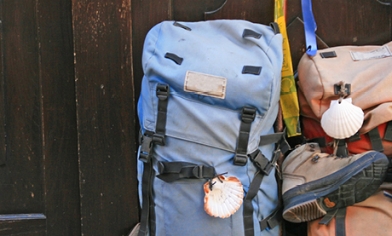
Going backpacking is one of life’s great adventures. But before you set off ...

If you're living with cancer but love to travel, can you get travel insurance ...
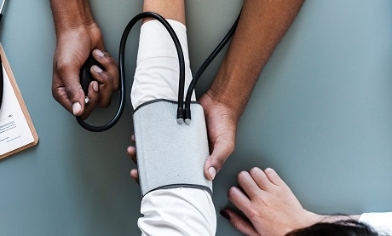
Travelling with high blood pressure is fine – but it’s important to make sure ...
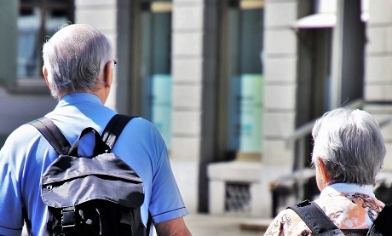
As you get older, being able to go where you want when you want is all part of ...

Travel insurance for a holiday in the UK isn't something you must have, but it ...

With festivals overseas becoming the new norm, festivalgoers need to do a bit ...
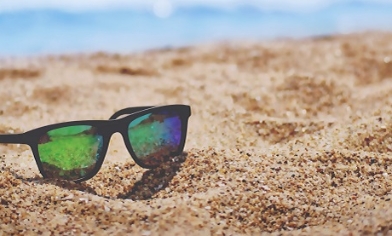
You should be able to get the right cover to travel abroad if you’re diabetic, ...

It's a proud feeling when children turn eighteen and start holidaying on their ...

If you're travelling abroad as a family, it makes sense to take out insurance ...

Fancy trekking in a remote Asian rainforest? A wild time in New York? Flying ...

If you're travelling to an EU country from the UK, make sure you take a Global ...
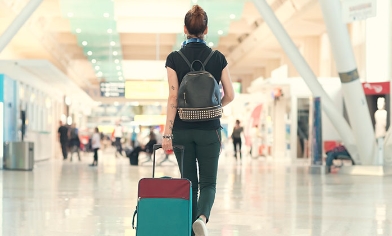
Do you need travel insurance for your trip? Is travel insurance worth it? And, ...

Learn about the different types of travel insurance available from Post Office, ...
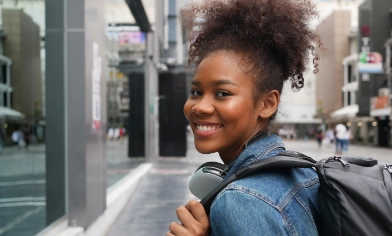
Exploring the globe can be scary, but there’s so much to find at the edge of ...

The opportunities to combine business and leisure have never been greater. You ...
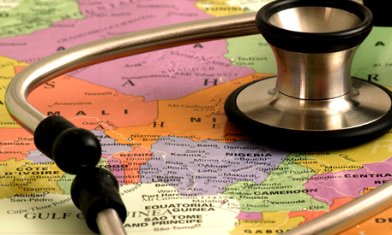
There’s no better feeling than planning an amazing trip to an exotic ...
Advertiser Disclosure
Many of the credit card offers that appear on this site are from credit card companies from which we receive financial compensation. This compensation may impact how and where products appear on this site (including, for example, the order in which they appear). However, the credit card information that we publish has been written and evaluated by experts who know these products inside out. We only recommend products we either use ourselves or endorse. This site does not include all credit card companies or all available credit card offers that are on the market. See our advertising policy here where we list advertisers that we work with, and how we make money. You can also review our credit card rating methodology .
The Complete Travel Packing Checklist for 2024 & the Best Packing Tips [Printable]
Erin Miller
Content Contributor
188 Published Articles
Countries Visited: 26 U.S. States Visited: 28
Keri Stooksbury
Editor-in-Chief
35 Published Articles 3250 Edited Articles
Countries Visited: 47 U.S. States Visited: 28
![checklist for travelling to uk The Complete Travel Packing Checklist for 2024 & the Best Packing Tips [Printable]](https://upgradedpoints.com/wp-content/uploads/2022/01/Woman-packing-bag.jpeg?auto=webp&disable=upscale&width=1200)
Table of Contents
General packing tips & tricks, apps for packing assistance, apps for itinerary management, before leaving the house.
We may be compensated when you click on product links, such as credit cards, from one or more of our advertising partners. Terms apply to the offers below. See our Advertising Policy for more about our partners, how we make money, and our rating methodology. Opinions and recommendations are ours alone.
When it comes down to it, packing for a trip (domestic or international) can be stressful. Do you wait until the last minute? Put off researching what you’ll need for certain activities or weather at your destination? Get distracted easily, or have young kiddos that need attention? It happens to the best of us!
On one hand, if you under-pack you might not be prepared. But if you over-pack, you run the risk of incurring hefty baggage fees or missing out on space to bring home that lovely souvenir. If you forget an essential travel document, you could even miss your trip altogether! We get stressed just thinking about it!
That’s why Upgraded Points is bringing you a guide full of packing tips and tricks, a printable travel checklist, a list of apps to help you out, and reminders for to-do’s around the house before you leave.
We’re here to assuage your anxieties and make sure you’ve got what you need, you’ve cut what you don’t, and there’s no wallet/phone/swimsuit/teddy bear left behind!
Hot Tip: Don’t forget to also check out our “Carry-On Travel Essentials” guide where we’ve compiled a “His” and “Hers” list of some great products that we simply can’t do without when we travel!
📋 Click To View Our Printable Travel Packing List >> 📋
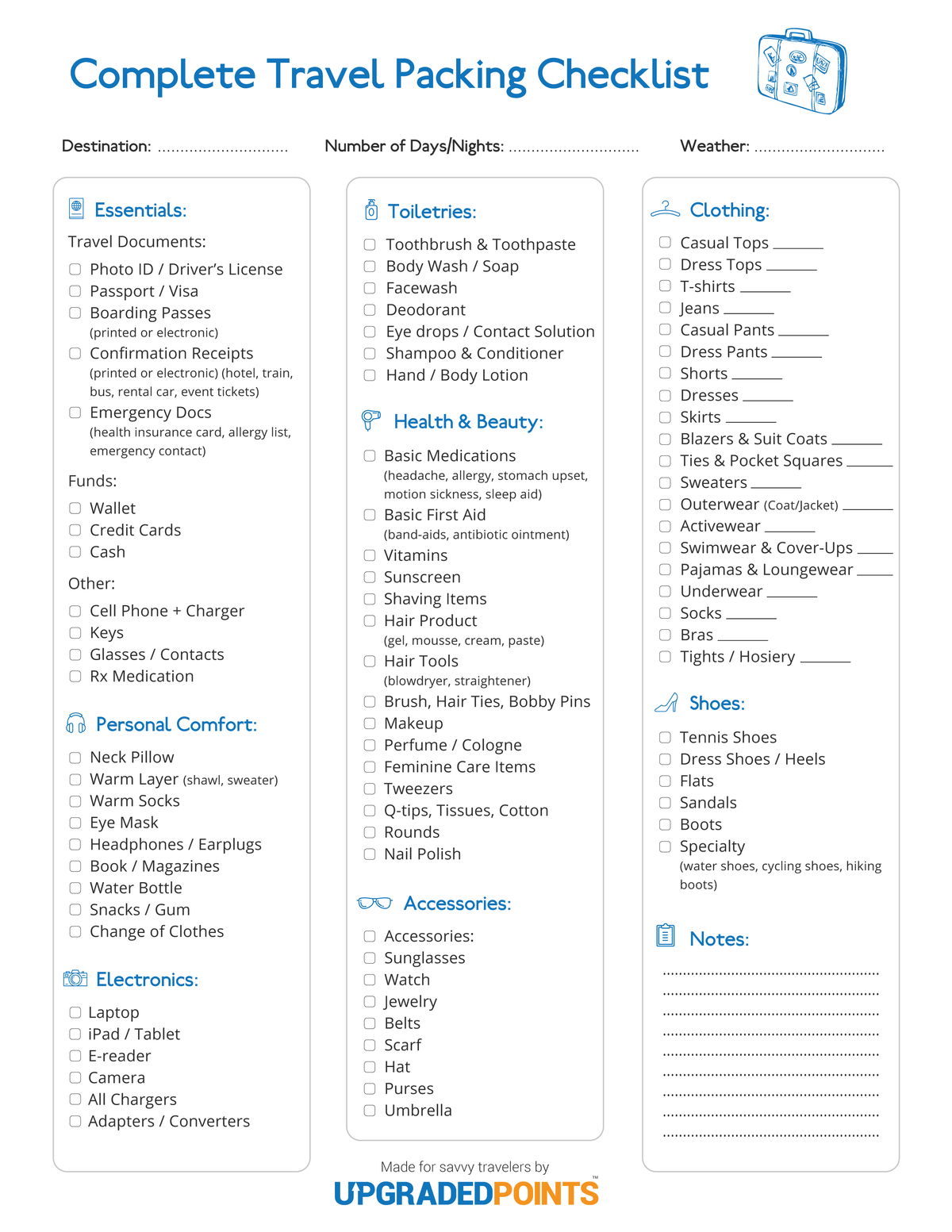
Before you even take your suitcase out of the closet
Check the weather at your destination.
This seems intuitive, but you’d be surprised how many people are stuck traveling in rainy season without a raincoat.
Note how many days/nights you will be away.
This will help you decide the number of necessary outfits. Obviously, how often you prefer to wear the same clothes plays a part in this as well.
Note any special activities/events you may partake in.
Traveling for a birthday? You don’t want to forget that heartfelt gift you bought weeks in advance. Going to a wedding? It’d be a shame if you showed up without your suit. Hiking in Hawaii? Your water-shoes won’t get much use if you leave them behind.

Make a packing list early and review it at least twice. (Yes, twice.)
You can easily find printable vacation packing lists online (like ours above), or you can write out your own. There are also a number of apps you can utilize if you prefer something more tech-based. Read about several of these below!
Timing is key here. If you jot things down or review your printed list in advance, it gives you the opportunity to take a second look with a fresh mind. All too often you’ll remember something you didn’t yesterday when your brain was thinking about pizza instead of packing.
If you’re printing a list that’s not trip specific, review it first and immediately cross off items you won’t need. Why bring a winter coat to the beach?
Take items you can grab at your destination off the list.
If you’re planning to travel with only a carry-on, this tip is especially important as it will save space (at least for your outgoing journey!).
Most times when traveling, your hotel will provide shampoo, conditioner, body wash, toothpaste, etc.; why waste space packing them? If you’re a little picky about your toiletries or you’re not staying at a hotel, you’ll probably still encounter a drugstore where you can buy anything you might need.
Purchase travel-sized containers or toiletries if you plan on bringing your own.
Remember regulations for the amount of liquids you can bring in a carry-on for a flight. You’ll want travel-sized containers if you plan on carrying liquids this way.
Even if you’re flying with a checked bag and are allowed more liquids, do you really need that 16oz bottle of shampoo for a weeklong trip? Cutting it will save you room for other essential items.
Choose the right luggage.
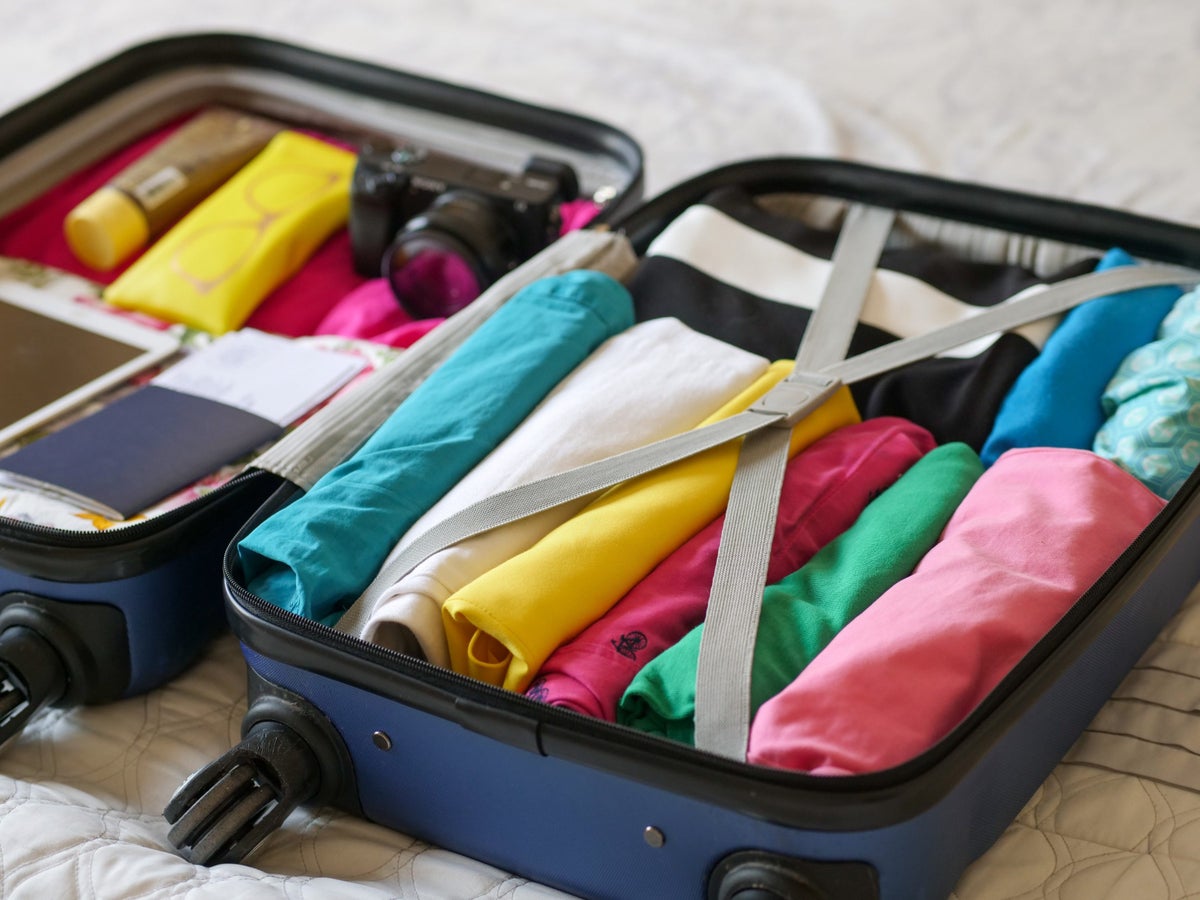
Yes, different airlines have different restrictions on sizes for carry-ons and checked bags but stick to some general guidelines and you should be safe.
For carry-ons, you’re generally accepted at/under max linear dimensions of 155cm/45in. For checked bags, you’re generally safe under 158cm/62in max linear dimensions. However, be sure to check the airline you’re flying with prior to packing, as some can be stingy!
You also want to seriously consider the type of bag you enjoy traveling with – shoulder bag , backpack , roller bag, hard shell , soft shell, etc. There are definitely loads of options so just remember, your bag shouldn’t stress you out, it should make traveling easier.
Hot Tip: We’ve done tons of research on this topic so don’t miss our articles on the best carry-on bags and the best checked luggage bags for any type of traveler.
When you’ve done your prep and you’re almost ready to pack
Essentials first.
Gather your most important items first. This includes all travel documents such as your passport, ID/driver’s license, boarding passes, hotel reservations, etc. This also includes anything you’ll seriously regret forgetting and can’t purchase while traveling: wallet , credit cards , camera , cell phone, etc.
This being said, there are a number of apps that can assist with itinerary management and decrease the number of printed documents you’ll need to carry. See our list of helpful packing apps at the end of this post.
Choose an appropriately sized suitcase.
If you only have 1 suitcase, then you’re set. If you’ve got more options, attempt to use the smaller one – most people tend to overpack when their suitcase is too large for their trip. You don’t really need an extra sweater, 2 more t-shirts, and another pair of boots just because they fit! Plus, your baggage will be a lot easier to handle if it’s smaller and lighter, which will cut your stress level significantly.
Lay everything out.

Laying all of your items out allows you to plan outfits and account for your days/nights away. When everything’s laid out, you can clearly see how much you’re bringing and spot missing items easier. This also includes shoes, accessories, toiletries, etc.
Dividing items into sections based on where they’ll be packed is also helpful.
Lastly, don’t forget to lay out your plane/travel day outfit and consider it with your other pieces.
Pick simple mix-and-match pieces to prevent overpacking.
In general, choose simple tops and bottoms that can be mixed and matched to make multiple outfits. Did you know that just 3 bottoms (pants, shorts, skirt, etc.), 4 tops (tee, tank, etc.), and 2 outer layers (sweater, coat, or cardigan) can make up to 24 different outfits??
Depending on the reason for your trip, you might need to pack a special item that can only be worn once (suit, bridesmaid dress, etc.), but try to keep these to a minimum! This step is key if you’re pressed for space.
PUT STUFF BACK!
Once you’ve laid out all your items, really consider the number of days you’ll be on your trip. Chances are you could stand to put a few things back in the closet in order to pack more efficiently. Remember, no one wants to pay a fee for overweight baggage or lug around extra clothes for no reason!
Pack it up.
You never thought we’d actually get to this step, did you? There are a number of recommended packing tips when it comes to getting everything neatly in the suitcase. This can be overwhelming, but if you pick up the right habits packing will seem much less stressful.
Check, double-check, and triple-check your essentials.
Put a checkmark next to each item you’ve packed and DON’T TAKE IT OUT OF YOUR BAG. If you’re not ready to pack an item, do NOT check the box! That’s exactly how you leave your phone at home on the charger next to your bed. “But the box was checked!!!” you’ll say…
(Note: this rule actually goes for everything, not just essentials.)
If you’re notorious for leaving essentials at home, print an extra travel checklist just for those items and tape it to your front door the night before you leave. Make a promise that you can’t walk out without reviewing the list one final time.
Fold, Interfold, Bundle, or Roll?
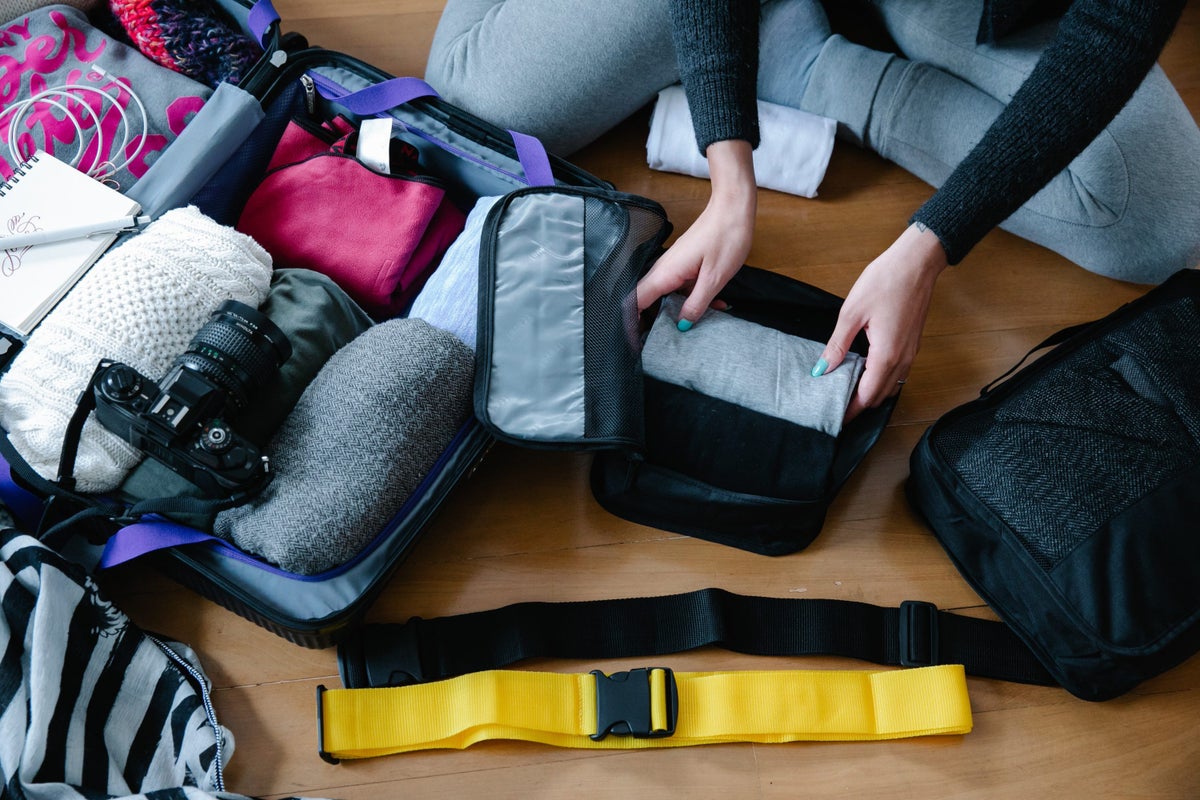
By now you’ve probably heard that old-fashioned folding isn’t the best method to use when it comes to packing, especially in tight cases. If you have the room to spare, virtually any of these methods will do.
Interfolding involves layering clothes on top of each other in a top-to-bottom, bottom-to-top format, then interweaving them as you fold them together. If you fold the items in accordance with the size of your suitcase, you’re left with a neat little bundle that will fit right in. Additionally, this style of folding will leave your clothing virtually wrinkle-free.
Bundle packing is very similar to interfolding, but you are tightly folding or wrapping your clothing items around a soft core (like a dopp kit , stack of underwear, cloth zippered jewelry bag , etc.). Bundle packing is also said to reduce wrinkles and save space.
Many people also recommend rolling when packing your clothes – at least for softer items and jeans. Again, this method tends to save room and reduce creasing in the process.
If none of the above methods are doing the trick and you don’t have the option of a hanging garment bag , it may be beneficial to learn the proper way to fold nicer items (like a dress shirt or suit coat ) for the best results.
Pack liquids in secure bags.
Toiletries that can leak will leak. These should be placed in a plastic zippered bag or another secure bag of your choosing. Some travelers even encourage cutting small squares of plastic wrap to cover the opening between bottles and their lids in attempts to prevent further seepage.
Utilize shoe space when you can.
Rolled-up socks, belts, gloves, stocking caps, and other small items can easily fit into shoes (as long as they’re relatively clean and not smelly!). This also helps the shoe hold its shape throughout your travels. Rolled-up belts can also be used to keep a shirt collar stiff if needed.
Prevent dirty shoes from soiling clothes.
Pack them in a separate space or utilize plastic bags/shower caps to cover the bottoms and prevent dirtying the rest of your clothing. Have a delicate pair of dress shoes or heels? Pack them in their own bags if possible, or clean the bottoms and wrap with a durable garment.
Toss a dryer sheet into your suitcase to keep things smelling fresh.
While you’re at it, grab a stain pen or stain wipes for your carry-on. If you happen to spill on one of the only tops you’ve brought and don’t have laundry facilities, you’re cutting your number of outfits drastically. If you know you’ll have laundry facilities or need to wash your clothes by hand, you can purchase individual detergent packets.
Pack a change of clothes in your carry-on.
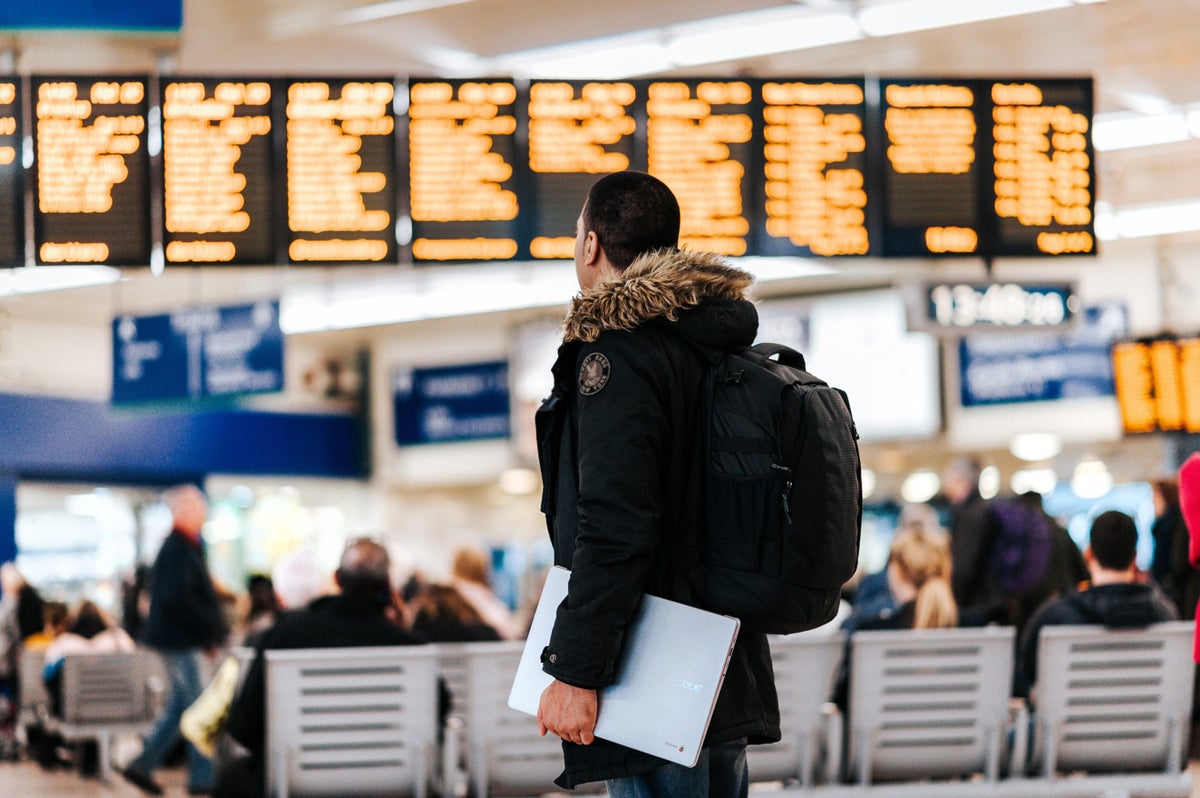
By packing a change of clothes and undergarments in your carry-on , you’re covered for at least a day if your baggage gets delayed or lost. Some travelers may want to pack an extra pair of shoes just in case.
Similarly, if you’re heading to a beach locale, pack a swimsuit and sandals . If you have to wait to check into your hotel, you can head to the pool while the concierge keeps your luggage.
Keep expensive/irreplaceable items on your person.
As a general rule of thumb, you should leave irreplaceable items at home. This includes objects such as expensive jewelry and heirlooms. If you must travel with them, these items should be kept with you at all times. Do not trust them to be safe when placed in checked baggage; if your suitcase is lost, delayed, or stolen, you’re out of luck.
Similarly, if you must travel with official documents such as birth certificates or social security cards, check to see if a certified copy will suffice. Or maybe take a photo on your phone for less hassle. Otherwise, the same rule applies to these irreplaceable documents.
Follow the TSA 3-1-1 rule for liquids in carry-on baggage.
3 – Travelers may carry liquids, aerosols, gels, creams, and pastes in containers of 3.4oz (100ml) or smaller.
1 – These items must fit into 1 clear plastic quart-sized bag.
1 – Only 1 bag per passenger is allowed.
Remove this bag from your carry-on and place it separately in the screening bin. This is meant to slightly expedite passing through security .
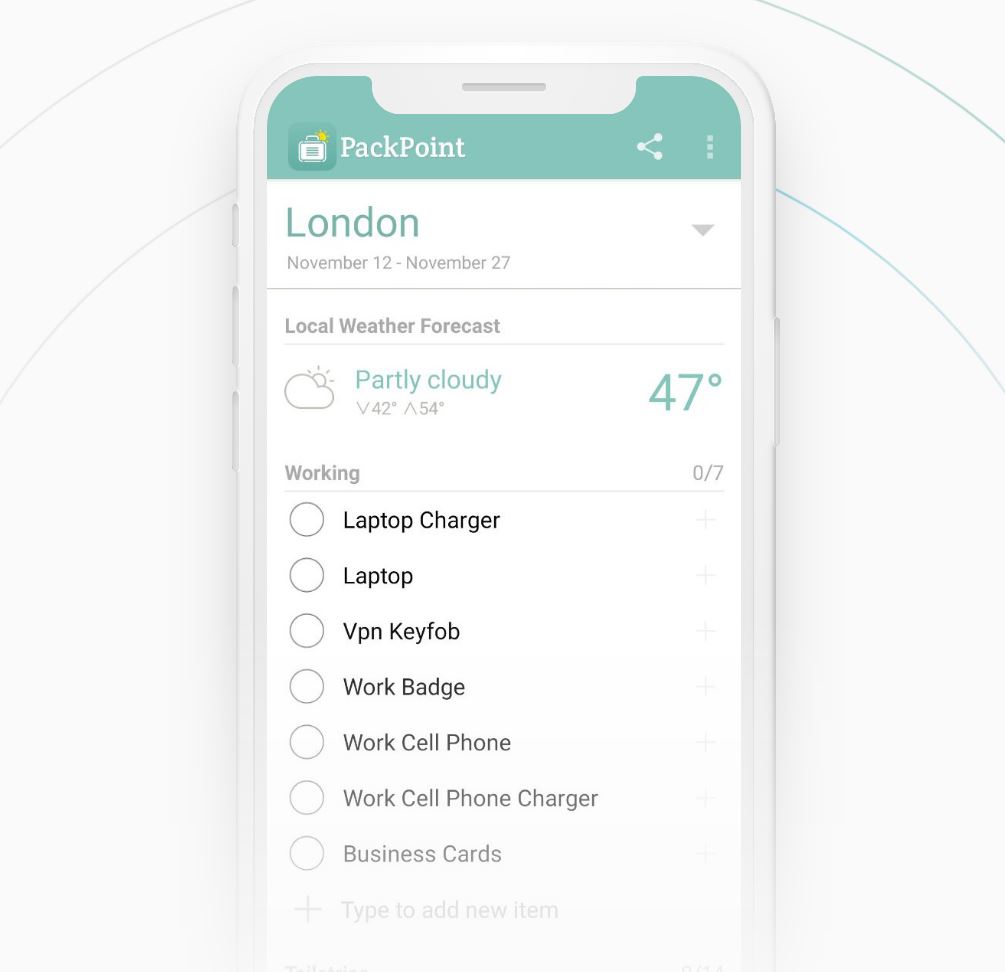
The following apps can be ultra helpful for those who prefer a mobile device to the standard pen and paper methods.
Evernote: While Evernote isn’t technically travel-oriented, it’s all about lists and can be a big help for packing. With Evernote, you can sync your packing list across all your devices, making it easy to keep track of things no matter where you are…even out at the store buying items from your list!
Evernote also enables sharing notes with others, which is especially helpful for group trips. Need reminders? No problem, you can set alerts in Evernote to keep you on top of your game.
Packing Pro: This app is everything you ever wanted if you’re a list maker, and everything you didn’t know you needed if you’re a forgetful person. Packing Pro helps travelers get organized via packing lists. From templates and suggestions to customizable designs, Packing Pro has options for every type of traveler. Users are allowed an unlimited number of packing lists of an unlimited length, and you can even add images, alerts, and mark “need to buy” items.
It also has iCloud support and the ability to share your lists via email, AirDrop, Dropbox, etc. You can also export and edit your lists with Excel, Numbers, or Google Docs. If you’re the type that physically needs to cross things off, you can send directly to a printer too.
The Expert List-Making Assistant is a cool feature if you’re low-maintenance: it will take your parameters (number of people, destination, weather, etc.) and automatically create lists for you.
PackPoint: PackPoint’s purpose is to take the guesswork out of packing. The app pretty much tells you what to pack based on how long you’re traveling, where you’re going, the weather when you get there, and any activities you have planned (chosen from a pre-defined list in the app). With PackPoint Premium, users can connect to TripIt, share their lists across devices, and add customizable packing items/activities.
Travel List: Travel List seems to have fewer bells and whistles. You can do many of the same things as with Packing Pro and PackPoint: create customizable packing lists, sync across your devices, share with other people, and create alerts/reminders. One nice component is their calendar view, which gives a different type of visualization that some people really prefer. And this one is compatible with Apple Watch, which can be a huge organizational perk.
Lists To Do: This app keeps things simple for general to-do lists and is super easy to use. See your list’s percentage progress for a clear visual on how much you have left to do/pack before jetting off and set yourself reminders and share lists with your travel companions.
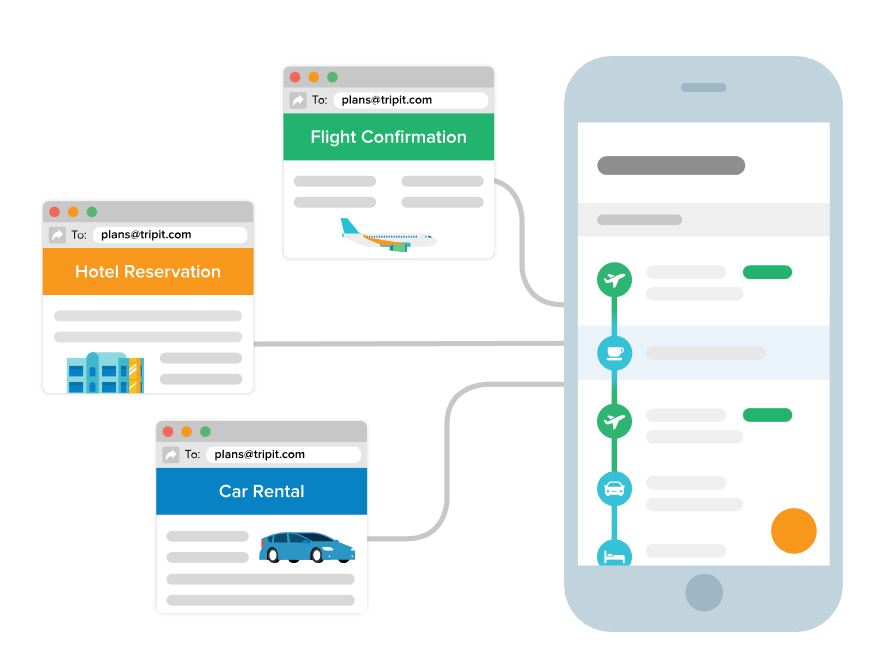
The following apps are helpful for keeping all your travel information in one place. From flight itineraries to hotel confirmation, event tickets to dinner reservations, they’ve got you covered. Plus, this means fewer printed travel documents you need to worry about carrying with you.
Google Trips: In a nutshell, Google Trips seamlessly integrates reservations (flights, hotels, rental cars, etc.) from your Gmail and creates a specific “trip” in the app. These trips are like folders of information including some basic categories like Reservations, Things to Do, Saved Places, Day Plans, Food & Drink, Getting Around, and Need to Know.
It also provides opportunities for travel inspiration, traveler reviews, dining/drink options, and encyclopedic information on several hundred top cities and attractions around the globe.
Also good to note: when you download your trip, everything is available offline in case you’re stuck without WiFi or data.
Kayak Trips: Part of Kayak’s main app includes a platform called Trips, which acts as an itinerary management app to keep all your pertinent travel information together. With Trips, you can forward your booking confirmations to [email protected] , where your itinerary is managed for you in a nice timeline format with maps and important info all on one screen.
Kayak Trips gives you the ability to send other people access to your travel plans through sharing options, link to your calendar app for planning consistency, and receive SMS and email flight alerts.
TripIt: TripIt is one of the most popular travel organization apps on the market. The app automatically imports flight, hotel, rental car, and other booking confirmations ( concert tickets from StubHub, dinner reservations from OpenTable, etc.) from your e-mail. If you don’t appreciate the e-mail scan, you can always forward your emails to [email protected] or manually input all the information into the system.
TripIt then creates an itinerary in an easy-to-read format, including space for directions between airports, rental car pickup, and hotel details. TripIt also allows for calendar syncing and makes it easy to send your travel info to family/friends by sharing via text, Evernote, LinkedIn, Slack, or WhatsApp.
With TripIt Pro, users get real-time flight alerts, help to find alternative flights, an airline seat tracker for better seats, reward program points tracking, and interactive airport maps.
In this section, we list some steps you might forget to take when you’re in a hurry to leave for vacation.
Remember to:
- Download your travel resources (guidebooks, language apps, etc.)
- Notify credit card companies of upcoming travel if required (international trips)
- Set an email auto-responder if necessary
- Take out the garbage
- Check the washing machine for wet clothes
- Check the dishwasher for dirty dishes
- Turn off all lights and electronics
- Set lighting timers
- Water the plants
- Drip taps (in cold climates where pipes could freeze)
- Close/lock all doors and windows; pull all curtains
- Set alarm system
For longer trips, don’t forget to:
- Empty the refrigerator/pantry of perishable food
- Unplug electronics
- Put a hold on your mail
- Consider having a friend check on your house from time to time
The Upgraded Points team is always jetting off somewhere and even we still have trouble packing sometimes!
Additionally, if you’re interested in “the best of the best” travel products to up your packing game, check out these posts:
- All Our Best Travel Product Reviews – In One Place
- The Best Checked Luggage Bags For Any Traveler
- The Best Carry-on Luggage Bags for Any Traveler
- The Best Travel Duffel Bags on the Market
Lastly, if you’re looking for the top travel-related gifts, we’ve got you covered with our Best Gifts for Travelers .
Frequently Asked Questions
Is it better to fold or roll clothes in a suitcase.
Whether it’s better to fold or roll clothes for your suitcase may depend on a number of things. If you’ve no concern about saving space, folding could be just fine. However, if you’re trying to fit a lot of clothes into a small bag, there’s no shortage of youtube videos out there which prove rolling clothes can help with this task.
Additionally, interfolding and bundling are other techniques that could be helpful space savers. However, to save the most space, vacuum bags will be your best bet – just keep in mind your weight limit when packing a lot of things into one case!
Do packing cubes really save space?
Packing cubes don’t necessarily save space but they definitely help you stay organized when packing.
They can also help by keeping items separated — who wants smelly gym clothes next to their fancy dinner outfits?
How do I maximize space in my luggage?
To maximize space when packing, try using these methods for your contents: roll, bundle, or interfold (explanations above). Each has its own special technique but all can help you save space and fit more into your luggage of choice.
Another quick space-saving tip? Utilize typically unused space. For example, pack socks or belts inside your shoes.
How to I pack clothes without wrinkling them?
Here are a few quick tips to decrease wrinkling when packing your clothes into a suitcase: iron first, use a roll or interfold method, pack wrinkle-prone items in garment bags or utilize tissue paper between folds and layers, and/or choose fabrics that are less likely to wrinkle in the first place (wool, Tencel, knit, cashmere, polyester, nylon, spandex).
How should I pack toiletries in my suitcase?
When packing toiletries, you’ll want to be sure they’re kept separate from your clothes in a special bag or case. It doesn’t have to be anything fancy — a Ziplock baggie will do — but this will prevent the leaking of liquid onto your clothing items.
Additionally, you can place a small piece of cling-wrap between the bottles and lids of your liquids to prevent leakage.
If you’re bringing them in your carry-on, you’ll want to be sure you’re adhering to the 3-1-1 rule (use 3 oz containers max, in 1 quart-sized bag, with one bag per traveler) in order to pass easily through security.
Should I pack valuable items in my suitcase?
Always keep valuable items on your person while traveling. This includes identification cards, passports, visas, money, credit cards, jewelry, important medications, etc.
Was this page helpful?
About Erin Miller
An experienced points hacker, Erin is Alex’s partner-in-crime and contributes to Upgraded Points with in-depth guides and relationship management. Erin’s work has been cited in multiple major publications.
INSIDERS ONLY: UP PULSE ™

Get the latest travel tips, crucial news, flight & hotel deal alerts...
Plus — expert strategies to maximize your points & miles by joining our (free) newsletter.
We respect your privacy . This site is protected by reCAPTCHA. Google's privacy policy and terms of service apply.
Related Posts
![checklist for travelling to uk The 10 Best Packing Cubes for Travel [2023]](https://upgradedpoints.com/wp-content/uploads/2022/01/Packing-Cubes.jpg?auto=webp&disable=upscale&width=1200)
UP's Bonus Valuation
This bonus value is an estimated valuation calculated by UP after analyzing redemption options, transfer partners, award availability and how much UP would pay to buy these points.
You are using an outdated browser. Please upgrade your browser to improve your experience.
Card Accounts
Business Accounts
Help & Support
Personal Cards
Business Cards
Corporate Solutions
Online Travel
Travel Resources
Business Travel
Travel Money
All Insurance
Benefits and Offers
Manage Membership
It appears that JavaScript is either disabled or not supported by your web browser. JavaScript must be enabled to experience the American Express website and to log in to your account.
American Express Travel UK
Travel Checklist & Essentials
Whether it’s applying for a visa, the rules of hand luggage, or buying your currency before you travel, the American Express Travel Checklist will make sure you’re fully prepared and ready for your adventure to begin.
Travel Advice: Coronavirus (COVID-19)
At American Express, the health and safety of our Cardmembers is a top priority. Before leaving the house, find out more about how we and our travel partners are keeping you safe during the Coronavirus pandemic with our essential travel advice.
Coronavirus (COVID-19) Travel Advice
Know your destination before you travel
You’ve probably already researched the local attractions and best restaurants at your destination, but don’t forget about other information you need to know, such as last minute travel warnings due to COVID-19.
There may be some restrictions imposed at the destination such as additional entry requirements, requiring a negative COVID-19 test result prior to travel, or restrictions & closures of hotel amenities or other tourist facilities. Be sure to review the latest government advisories and travel provider policies before booking or travelling.
Foreign Travel Advice
Know your airline's COVID-19 requirements
Travelling in the COVID-19 era requires you to have a little more knowledge before booking a flight. You can check your airline's COVID-19 policies by choosing from a list here . Be sure to contact your particular airline about any changes in travel rules, including:
- COVID-19 testing requirements prior to travel
- Current mask policies for kids and adults (throughout check-in, boarding and the flight itself)
- Traveling with infants on your lap
- Changes in meal service
- Updated seat spacing, and more
Check your airline's COVID-19 policies
Check your hotel's COVID-19 policy before you go
Make sure there are plenty of contactless options available at your hotel before you book. From online reservations and check-in, to mobile room keys, to contactless payments – most hotels are taking those steps and more to keep you safe, including:
- Mandatory staff/guest mask requirements
- Plexiglass barriers at check-in counters
- Signs reminding of physical distancing throughout the hotel
- Updated cleaning and disinfecting policies for surfaces and items (such as pens, room keys, tables, phones, doorknobs, light switches, elevator buttons, remote controls, etc).
- Changes in food and meal services
Check your hotel's COVID-19 policies
Visas and entry requirements
Depending on where you’re travelling to and the length of your stay you may need a visa to enter the country. For example, if you’re travelling to the USA you’ll need an Electronic System for Travel Authorization (ESTA). Avoid an embarrassing encounter at the airport by checking the Foreign & Commonwealth Office’s entry requirements advice for your destination.
Foreign Office Travel Advice, by Country
Check your passport is valid
Don’t get caught out by a lapsed or about to be lapsed passport. Some countries insist you still have at least six months left on your passport before they allow you to enter. Check your passport has got plenty of time remaining on it, and if it doesn’t, get your passport renewed or extended.
Renewing or extending your passport
Order your currency online
Don’t leave it until the last minute to order your local currency. Some currencies may need ordering in advance, or, depending on your destination, you may find you need travellers’ cheques or US dollars as backup. Remember your American Express card can also be used and is accepted all around the world.
Order currency online
Using your American Express card abroad
Ensure you’re insured
As an American Express Cardmember, you may have some travel insurance in place already. Check the details in case you need to add extra cover for certain sports, valuables, healthcare or anything else relevant to your trip. UK residents may be eligible to apply for a UK Global Health Insurance Card (GHIC) or an UK-issued EHIC for travel in the EU. To be safe you should buy travel insurance that comes with healthcare before you travel.
American Express Travel Insurance
Apply for a European Health Insurance Card
Packing your bag....
While forgetting something like pants or socks can be annoying, they're generally easy to replace. So, aside from the obvious packing necessities, here are some essential items to keep in mind that aren't so easily replaceable— especially if you're faced with an unexpected delay or change of plans due to COVID-19. Make sure you add these to your holiday packing list:
Health Supplies
Medication, copy of your prescription/s, eye glasses, contact lenses and solution, contraception, extra masks/ hand sanitizer (COVID-19)
Travel Documents
Passport, visas, boarding passes and tickets, insurance, vaccination certificates, EHIC card if applicable, drivers licence/ID. You should email copies of these to yourself for backup.
Useful Numbers
The Embassy or Consulate, your Airline, American Express support numbers, your travel insurance company, emergency contacts. You should email these to yourself for backup.
And don't forget...
Your mobile phone and charger, travel adapters, house/car keys (for your return home), your wallet and of course, your American Express Card.
And finally…. Enjoy your trip!
Advance Passenger Information (API)
You might find that your airline needs to collect certain personal details about who’s travelling in your party. For example their passport number, name and date of birth. This is usually done for security reasons and varies from country to country. API should not affect your journey, but it’s useful to be aware of it.
Advanced Passenger Information before you travel
Vaccinations and medications
You may need vaccinations for your trip. Speak to your GP or nurse who will be able to advise you on what’s required. Try to do this around eight weeks before you travel as some vaccinations need time to start working or require several dosages. If you regularly take medication make sure you have enough to cover your holiday period, and it’s useful to take a copy of your prescription or a letter from your GP with you for customs.
NHS Travel Vaccinations
Can I take my medicine abroad?
Deep Vein Thrombosis (DVT)
Deep Vein Thrombosis (DVT) is a rare blood clotting disorder that’s been known to happen on flights. Luckily, there are some simple ways to reduce the risks, from staying hydrated to wearing flight socks or compression stockings. The NHS has some great advice on how to prevent DVT when travelling.
NHS - Prevent DVT (deep vein thrombosis) when you travel
Hand luggage
You should check hand luggage limitations with your airline before travelling. Some items, such as sharp objects and liquids above a certain amount, are not be allowed in the cabin with you, but your airline may also have restrictions on the amount and size of luggage you can take on board.
Hand luggage restrictions at UK airports
Are you fit to travel?
Pregnancy, recent surgery, epilepsy and fractures are some of the conditions that can affect your fitness to travel. If in doubt, always check with your nurse or GP.
NHS – Travel Health common questions
Travelling while pregnant
When can I fly after surgery?
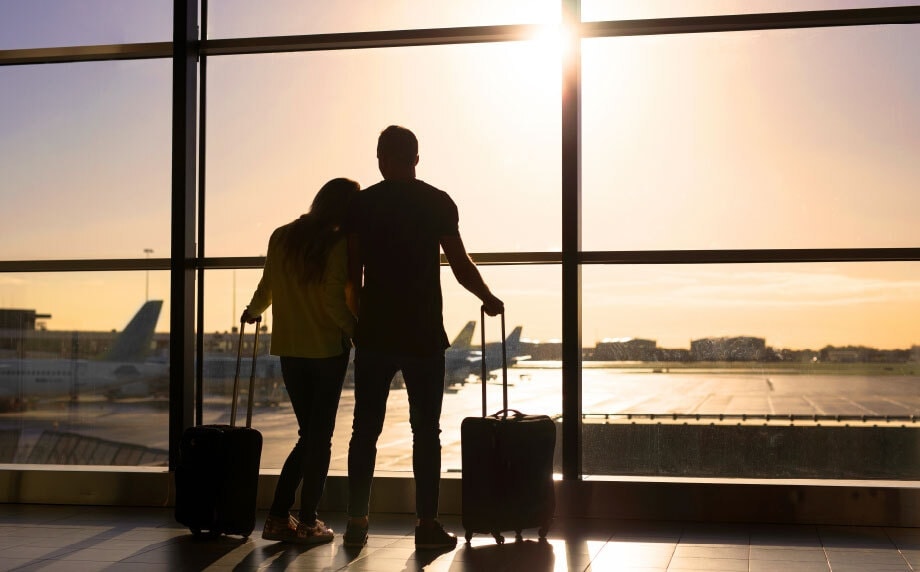
- American Express Travel Checklist
- COVID-19 Travel Information Hub
Travel services
- Membership Rewards
- American Express Travel sitemap
Travel support
- Travel Support
- Manage My Booking
- Frequently Asked Questions
Featuring reviews from

American Express Europe LLC (AEELLC) trading as American Express Travel, Belgrave House, 76 Buckingham Palace Road, London SW1W 9AX, United Kingdom is a member of ABTA (ABTA number C4330) and ATOL (ATOL number 0151). Being a member of ABTA (ABTA number C4330) means you have the benefit of ABTA’s assistance and Code of Conduct and this allows you to book with confidence. All the package and Flight-Plus holidays we sell are covered by a scheme protecting your money if the supplier goes out of business or is no longer able to provide the intended holiday. Other services such as hotels or flights on their own may not be protected and you should ask us what protection is available. American Express’s ABTA membership does not cover cruise bookings and should therefore not be relied upon when booking cruises or cruise packages. These bookings are covered by our third-party provider, ICE Cruise’s ABTA membership (ABTA number L6366). Many of the flights and flight-inclusive holidays on this website are also protected by the ATOL scheme, this ATOL protection does not apply to all holiday and travel services listed on this website. If you do not receive an ATOL Certificate then the booking will not be ATOL protected. If you do receive an ATOL Certificate but all the parts of your trip are not listed on it, those parts will not be ATOL protected. Please see our booking conditions for information, or for more information about financial protection and the ATOL Certificate go to: www.atol.org.uk/ATOLCertificate . Please contact us to confirm what protection may apply to your booking.
Cookies on GOV.UK
We use some essential cookies to make this website work.
We’d like to set additional cookies to understand how you use GOV.UK, remember your settings and improve government services.
We also use cookies set by other sites to help us deliver content from their services.
You have accepted additional cookies. You can change your cookie settings at any time.
You have rejected additional cookies. You can change your cookie settings at any time.
Register to vote Register by 18 June to vote in the General Election on 4 July.
- International travel, immigration and repatriation during COVID-19
- Entering England during COVID-19
Travel to England from another country – COVID-19 rules
Check if there are any COVID-19 rules in place for travel to England from abroad.
Applies to England
- Guidance for Northern Ireland
- Guidance for Scotland
- Guidance for Wales
Travel to England rules
When you travel to England, you:
- do not need to complete a UK passenger locator form before you travel
- do not need to take any COVID-19 tests before you travel or after you arrive
- do not need to quarantine when you arrive
This applies whether you are vaccinated or not.
It includes people who are transiting through England.
Other countries may have rules about what you need to do to leave the country to travel to England. You should check travel advice for the country you are travelling from.
How to stay safe while in the UK and on public transport
Check separate public health guidance on how to stay safe and help prevent the spread of COVID-19 while you are in the UK .
Travel provider and transport hub rules
Your travel provider, or the transport hub you travel through, may have COVID-19 rules in place. For example, they may require or advise you to wear a face covering.
You should follow any COVID-19 rules and guidance from:
- your travel provider – airline, ferry, coach or train company
- the transport venue – airport, port, coach or railway station
Travel abroad from the UK
Other countries may still have COVID-19 rules that you must follow to travel there from the UK .
Check the ‘Entry requirements’ section of foreign travel advice for all countries you will visit or travel through .
You do not need to take any COVID-19 tests to travel to England from mainland China.
Updated rules for people travelling from mainland China announced.
New rules for travel from China come into force today.
More information about COVID-19 testing requirements for travel from mainland China to England.
From 5 January, people flying from mainland China to England will be asked to take a COVID-19 pre-departure test.
When you arrive in England from abroad you do not need to take any COVID-19 tests or fill in a UK passenger locator form.
If you will arrive in England after 4am, Friday 18 March, you do not need to take any COVID-19 tests or fill in a UK passenger locator form.
If you began your journey in Russia, you do not need to complete a passenger locator form, or take a COVID-19 test before travel to England or on arrival.
If you began your journey in Ukraine, you do not need to complete a passenger locator form, or take a COVID-19 test before travel to England or on arrival.
From 9am Monday 28 February, you can fill in the UK passenger locator form up to 3 days before you arrive in England.
From 24 February, there is no legal requirement to self-isolate if you get a positive day 2 test result.
You do not need to take any COVID-19 travel tests or self-isolate on arrival in England if you qualify as fully vaccinated.
The testing and quarantine rules for international travel to England will change 11 February 2022.
You can now choose a lateral flow test or a PCR test as your post arrival test.
From 4am 7 January you do not have to quarantine on arrival in England if you qualify as fully vaccinated for travel to England.
Changes to rules for fully vaccinated people travelling to England from 4am 7 January 2022.
People who qualify as fully vaccinated for travel to England can now end self-isolation after 7 days with 2 negative lateral flow tests.
Further information about quarantine rules for children aged 4 and under.
People aged 12 years and over must COVID-19 test before they travel to England from abroad.
From 4am, Tuesday 7 December all people aged 12 years and over must also take a PCR or LFD COVID-19 test before they travel to England from abroad.
People who qualify as fully vaccinated must quarantine and take a PCR test before the end of day 2 after they arrive in England. Lateral flow tests will not be accepted.
From 4am 30 November 2021, fully vaccinated people must self-isolate and take a PCR test before the end of day 2 after they arrive in England. They may leave self-isolation if their PCR result is negative. Lateral flow tests will not be accepted.
South Africa, Botswana, Eswatini, Lesotho, Namibia and Zimbabwe will move onto the red list at 12.00 midday Friday 26 November. A temporary flight ban will be in place and all travellers who have been in these countries must quarantine and take tests.
Travel to England rules for children no longer depend on their place of residence.
Clarification about unclear or inconclusive test results.
From 4am 22 November 2021, all children aged 17 and under will not have to quarantine on arrival in England.
People who qualify as fully vaccinated for travel to England can book a lateral flow test for use from 24 October instead of a PCR test.
From 22 October, if you qualify as fully vaccinated for travel to England, you will be able to book an antigen lateral flow device (LFD) test instead of a PCR for your ‘on arrival’ test.
Rule changes for international travel to England for people who qualify as fully vaccinated.
Changes to amber list rules on quarantine and testing.
First published.
Related content
Is this page useful.
- Yes this page is useful
- No this page is not useful
Help us improve GOV.UK
Don’t include personal or financial information like your National Insurance number or credit card details.
To help us improve GOV.UK, we’d like to know more about your visit today. Please fill in this survey (opens in a new tab) .

IMAGES
COMMENTS
It should be valid for the whole of your stay. You may also need a visa to come into or travel through the UK, depending on your nationality. Check which documents you'll need to come to the UK ...
You will discover that many shops in the UK are really hot in winter so it is useful to remove layers easily. The London Underground can also be stifling even in winter so it is best to dress in layers to avoid overheating. 3 x sweater/long-sleeved tops. coat. 3 x leggings. 1 x trousers/jeans. 1 x dress.
Our foreign travel checklist aims to help you plan for a trouble-free trip. It is not exhaustive. No foreign travel can be guaranteed as safe, and you take personal responsibility for your own ...
What to pack for the UK in Spring and Autumn (Fall) Spring in Scotland means jeans, fleece jacket and scarf! Temperatures average between 5° - 13° in spring (40- 55°F) and between 14°- 8° (57- 46 °F) in autumn in the UK. Spring is a lovely time to visit the UK with daffodils and bluebells heralding the warmer weather.
3. Train prices are steep. Unlike some other countries in western Europe, England's train system was privatized many years ago, and this, along with other factors, has lead to some of Europe's highest train prices. Try to book ahead of time (around 12 weeks before travel for the best rates) and look out for cheap advance fares.
Windproof travel umbrella. The UK gets a lot of rain. In 2019, there were 164 days in which rain fell. It can range from light showers to torrential rain and snow, and it can rain in any season at any time. We recommend coming prepared with a windproof, travel-sized umbrella so you don't find yourself running for cover whenever the skies open.
A key part of any checklist for traveling to London is to make sure you have a valid passport, and check to see whether or not you need a visa to visit London on this site. Visas can take a long time to process, so make sure to start this part of your London travel planning far in advance. This is probably the most important part of preparing ...
Naturally you're going to want to bring your toiletries with you on your trip to London! You don't need much different for London and the UK than anywhere else, so just remember your essentials - toothbrush, toothpaste, deodorant, moisturizer, travel razor and any make-up or sanitary products that you might need.
UK VISA REQUIREMENTS ALL nationals of the countries and territories listed below in red (underlined) need visas to enter or transit the UK. ALL nationals of the countries and territories listed below in black need visas to enter or transit the UK landside. ALL visa nationals may transit the UK without a visa (TWOV) in certain circumstances.Please see below for details.
1. Travel document (passport) You must provide a valid passport or other travel document with all applications and when travelling to the UK. Your passport must have at least 1 page blank if you ...
Start with this international travel checklist of items to pack: Passport and visa. Medications. Insurance and ID cards. Cash, debit cards, and credit cards. Pen to fill out customs forms ...
The Ultimate Packing Checklist. To see the ultimate packing list, scroll down the page or click here for an editable PDF version that you can save or print out. To customize the list, simply ...
Here are some key items to have on your packing list for London. 1. Clothing. Maridav / Adobe Stock. No hard feelings if you love glaring clothes, but what you pick for your London wardrobe should be decent. London is one of the fashion capitals of the world, and smart, sensible dress is what the locals are used to.
Put containers of liquids into a clear resealable plastic bag which holds no more than 1 litre and measures about 20cm x 20cm. Take the plastic bag out of your hand luggage while queueing, ready ...
Call us in Washington, D.C. at 1-888-407-4747 (toll-free in the United States and Canada) or 1-202-501-4444 (from all other countries) from 8:00 a.m. to 8:00 p.m., Eastern Standard Time, Monday through Friday (except U.S. federal holidays). See the State Department's travel website for the Worldwide Caution and Travel Advisories.
Other Information for U.S. Citizen Travelers. Information for Travel Agents. Travel to High-Risk Areas. Traveling with firearms. Traveling with a pet. Travel during tropical storm season. FBI Safety and Security Information for U.S. Students Traveling Abroad. Customs and import restrictions. Global Entry.
Good travel insurance for everyone in your family should be top of the holiday checklist. It can provide extra reassurance as it may cover you for cancellation before your trip, missed or delayed flights, or lost, stolen luggage and other belongings such as passports and cash. Most importantly, it may cover emergency medical costs if you need ...
3 - Travelers may carry liquids, aerosols, gels, creams, and pastes in containers of 3.4oz (100ml) or smaller. 1 - These items must fit into 1 clear plastic quart-sized bag. 1 - Only 1 bag per passenger is allowed. Remove this bag from your carry-on and place it separately in the screening bin.
If you need a Standard Visitor visa, you must apply online before you travel to the UK and attend an appointment at a visa application centre. The earliest you can apply is 3 months before you ...
Medication, copy of your prescription/s, eye glasses, contact lenses and solution, contraception, extra masks/ hand sanitizer (COVID-19) Travel Documents. Passport, visas, boarding passes and tickets, insurance, vaccination certificates, EHIC card if applicable, drivers licence/ID.
Getting ready to travel to France? To summarise the above information, here's a handy pre-departure checklist of all the documents you need to travel to France from the UK. (Note: this checklist is for British citizens and UK residents travelling to France for less than 90 days) Document Checklist. Passport
When you travel to England, you: do not need to complete a UK passenger locator form before you travel. do not need to take any COVID-19 tests before you travel or after you arrive. do not need to ...